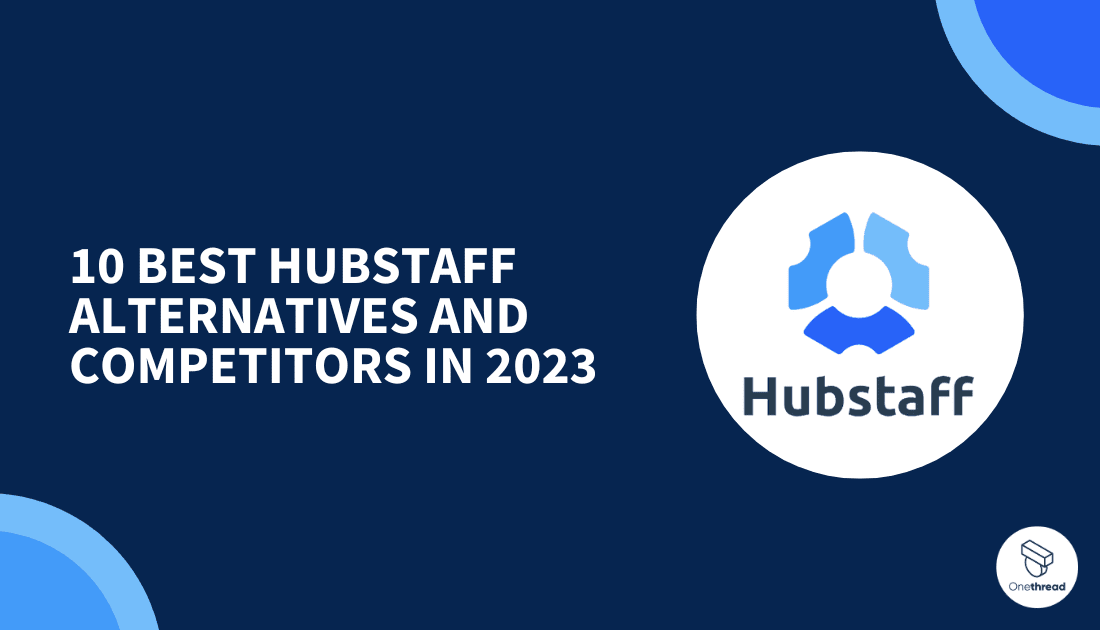Hubstaff, renowned for its precise time-tracking and productivity management, has become a staple in the world of project management. Yet, it’s not a one-size-fits-all solution.
You and I both know that the quest for the right tool can be as demanding as the projects themselves. What if there’s something out there that fits your unique needs even better?
Fear not! In the following guide, we’ll unravel the top 10 Hubstaff alternatives of 2023, offering fresh insights and tailored solutions that might just be the perfect match for your project management endeavors. Let’s dive in and explore what’s beyond the Hubstaff horizon.
Quick List of 10 Best Hubstaff Alternatives
- Onethread: A powerful tool for project management, Onethread is a versatile option with robust features.
- Trello: Known for its visually engaging boards and task management.
- Asana: Offers extensive collaboration tools and integration options.
- Time Doctor: Focuses on productivity tracking and performance analytics.
- JIRA: Designed for agile development and offers extensive customization.
- Monday.com: Intuitive and user-friendly, ideal for various project types.
- Wrike: Offers detailed project planning and time-tracking tools.
- ClickUp: Known for its flexibility in handling various project management methodologies.
- Zoho Projects: Focuses on detailed reporting and integration capabilities.
- Basecamp: Simplified communication and collaboration tools for teams of all sizes.
Our reviewers evaluate software independently. Clicks may earn a commission, which supports testing. Learn how we stay transparent & our review methodology
Onethread – The Best Hubstaff Alternative
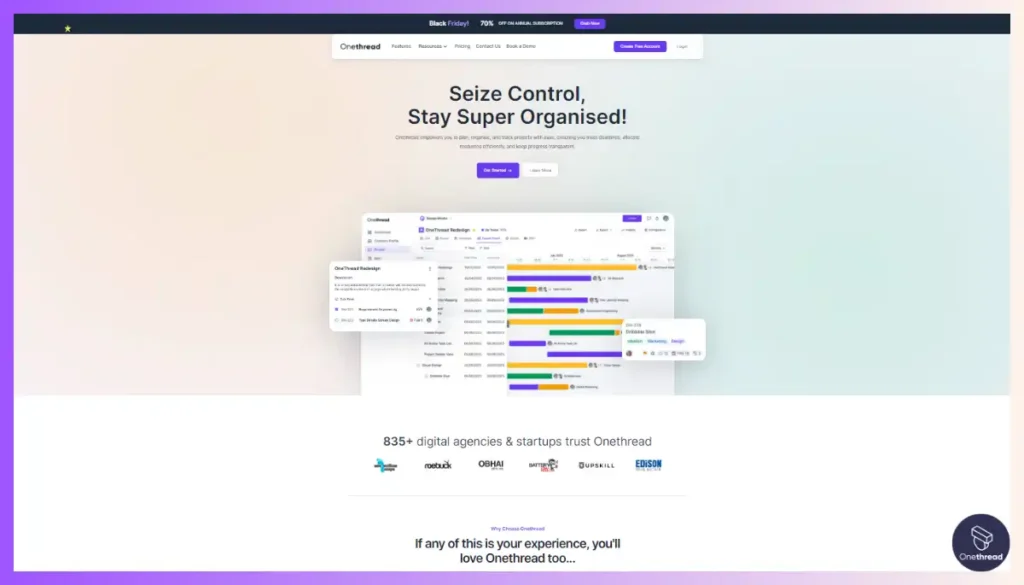
When it comes to finding a robust alternative to Hubstaff, Onethread stands out as a powerful contender. Designed with a keen understanding of what project managers need, Onethread takes the core functionalities of Hubstaff and elevates them to a new level.
Whether you’ve been searching for more streamlined reporting or a more intuitive interface, this tool seamlessly aligns with modern project management demands.
Below, we’ll delve into the distinctive features that make Onethread not just an alternative, but potentially a superior choice for your next project.
- Intuitive Time-Tracking
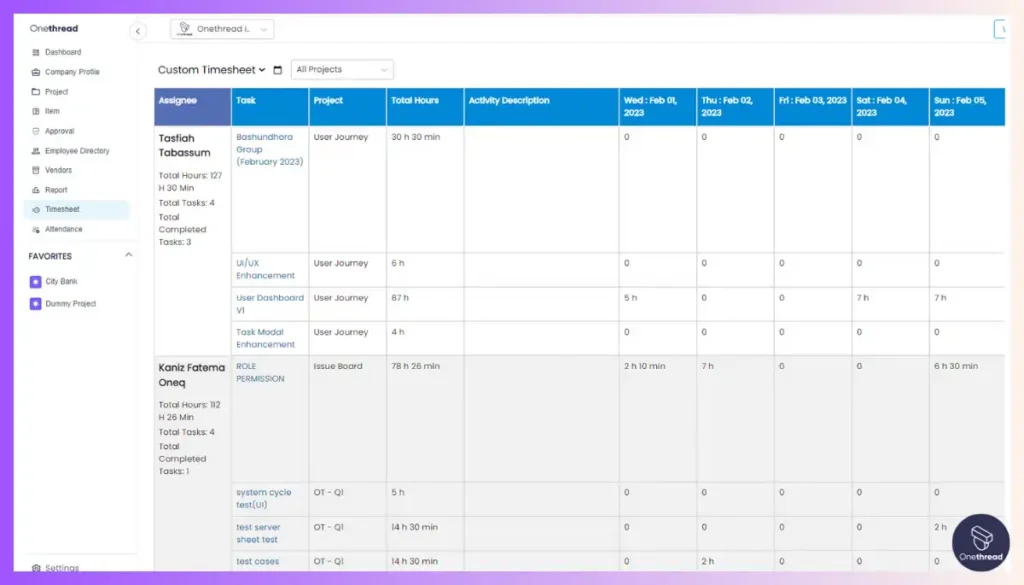
Onethread’s time-tracking functionality offers a seamless experience, allowing managers and team members to easily log hours. Unlike traditional systems, it provides insightful analytics and integrates with other tools, making it a smart choice for complex projects.
- Collaborative Workspace
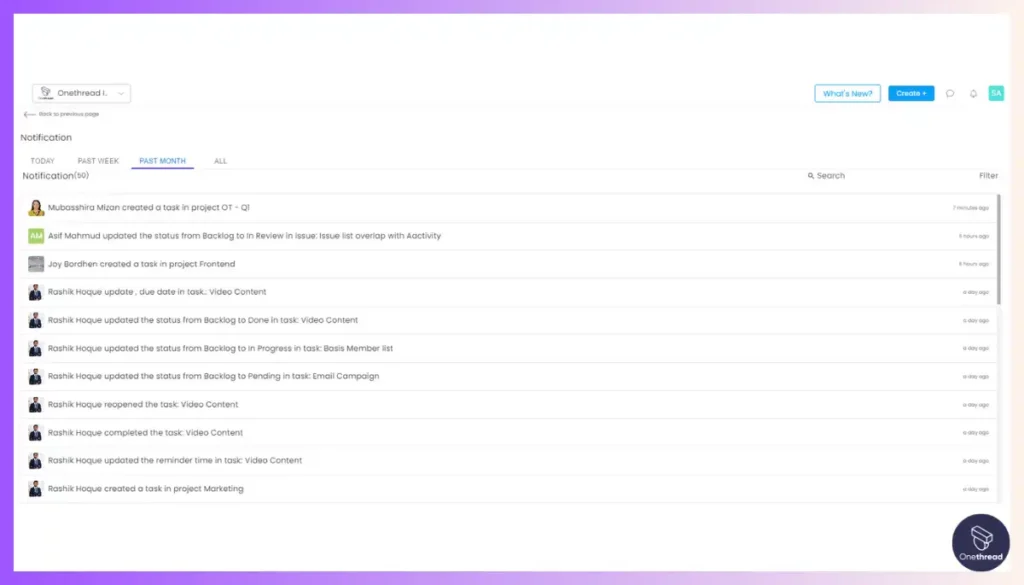
This feature enhances team collaboration by offering shared boards, real-time updates, and easy file sharing. It fosters better communication and ensures everyone stays on the same page, making project management a breeze.
- Customizable Reporting
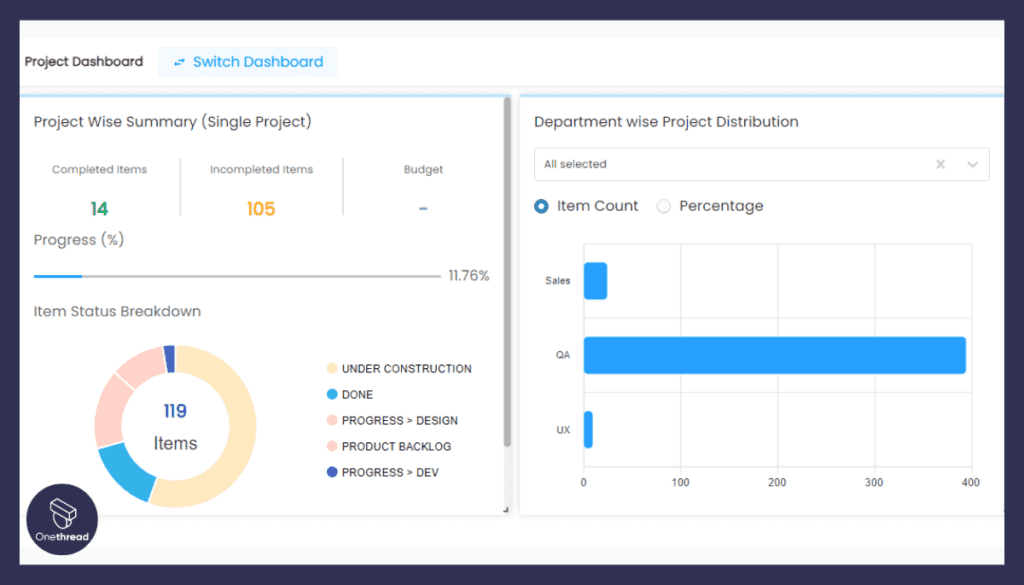
Onethread’s reporting feature provides flexibility in generating detailed reports tailored to a project’s specific needs. With a variety of templates and custom options, managers can quickly glean insights and make informed decisions.
- Scalable Task Management
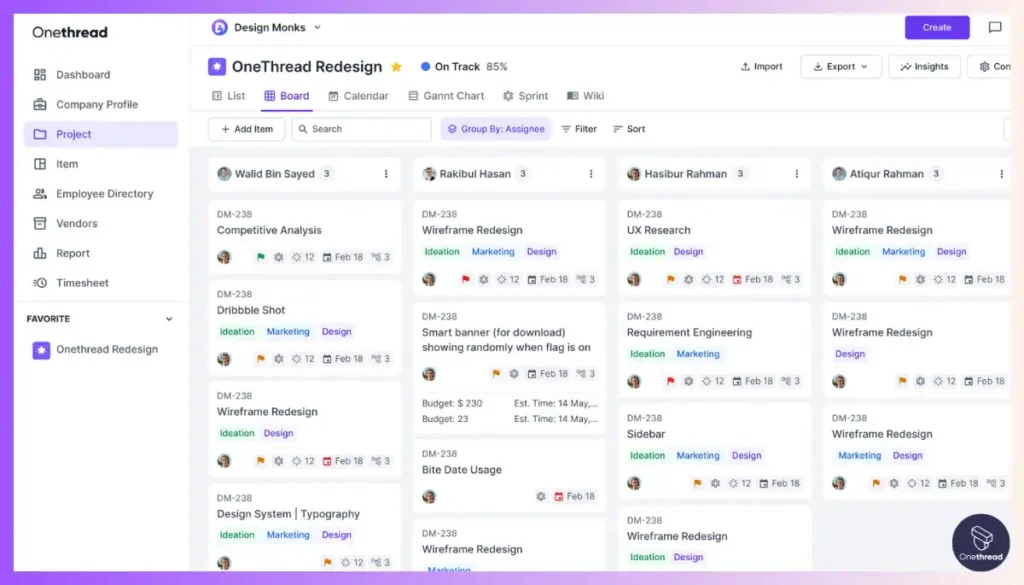
Managing tasks across various team sizes and complexities is made easy with Onethread’s scalable task management. From assigning tasks to tracking completion, it’s designed to adapt to your project’s evolving needs, promoting efficiency at every stage.
- Robust Security Measures
Security is paramount, and Onethread recognizes that. Its robust security measures ensure that your data remains protected and compliant with relevant regulations. With encryption, regular audits, and dedicated support, you can trust Onethread with your most sensitive information.
Pros and Cons
Pros:
- Onethread facilitates seamless team interaction through real-time chat, document sharing, and efficient feedback loops.
- The drag-and-drop interface of Onethread adjusts to your team’s unique workflow, promoting better organization and task management.
- With accessibility across various devices and systems, Onethread provides the flexibility of connectivity.
Cons:
- The abundance of rich features in Onethread might lead to overwhelming users, especially those who prefer simpler tools.
Customer Ratings:
G2: 4.7 (5 reviews)
Onethread vs Hubstaff: A Quick Comparison
Here’s a quick look at how Onethread stacks up against Hubstaff:
Feature | Onethread | Hubstaff |
Intuitive Time-Tracking | ✓ | ✗ |
Collaborative Workspace | ✓ | ✗ |
Customizable Reporting | ✓ | ✓ |
Scalable Task Management | ✓ | ✓ |
Robust Security Measures | ✓ | ✓ |
Platforms
Onethread is available on Windows, macOS, Android, iOS, Linux, and web browsers, offering flexibility across various devices and operating systems.
Pricing

- Free Trial: Explore core features with no commitment.
- Growth Plan: $3.6 per user/month, ideal for small teams.
- Scale Plan: $6 per user/month, includes advanced reporting and support.
What Is Hubstaff and Why Is It Used?
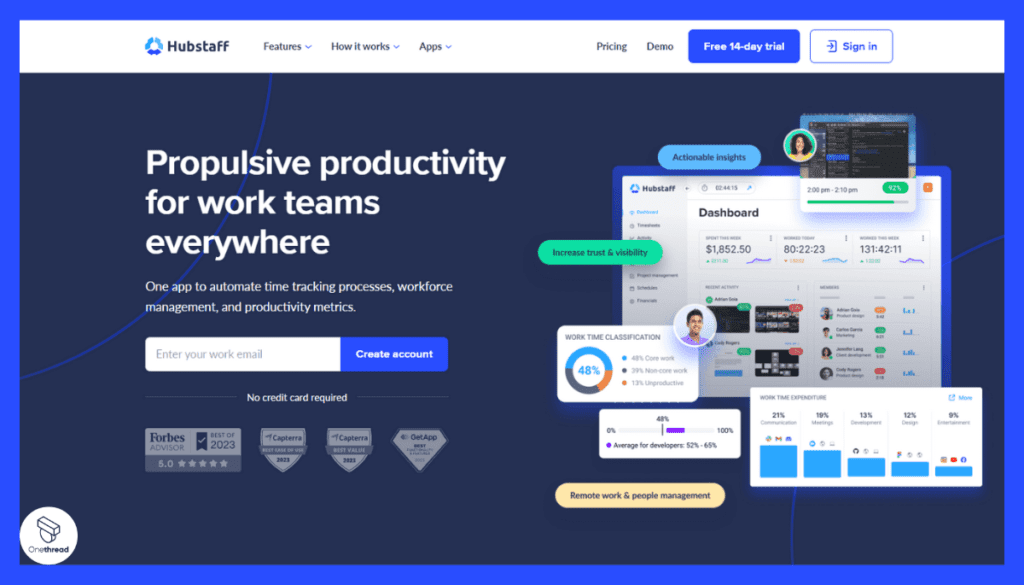
Hubstaff is a well-known project management and time-tracking tool utilized by businesses around the globe. Its strength lies in offering real-time tracking and productivity insights, catering to freelancers, remote teams, and enterprises alike.
With its rich features, Hubstaff ensures that managing projects and monitoring employee performance is convenient and efficient.
Notable Features of Hubstaff:
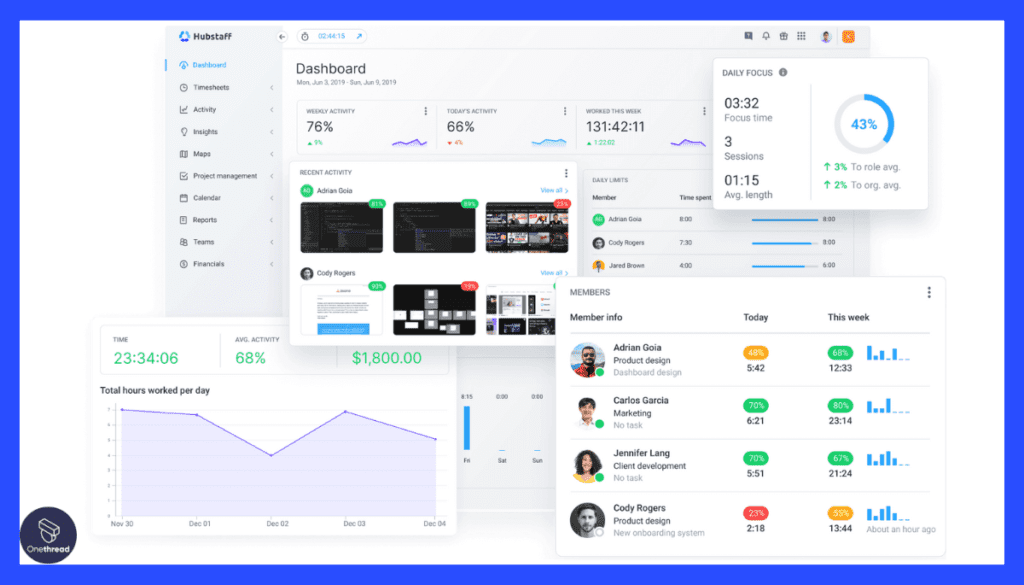
– Time-Tracking: Accurate logging of work hours.
– Productivity Monitoring: Insights into individual and team performance.
– Geolocation Services: Track locations for on-field teams.
– Automated Payroll: Simplifies payroll processing.
– Integrations: Compatibile with other popular tools.
– Customizable Reporting: Tailor-made insights for better decision-making.
Why Search for Hubstaff Alternatives?
Reasons why people might look for an alternative to Hubstaff:
– Limited Customization: Hubstaff’s features might not be adaptable to all business needs.
– Pricing Concerns: Some plans may be out of budget for smaller teams.
– User Interface Issues: The interface might not be intuitive for all users.
– Lack of Specific Features: Some unique or industry-specific functionalities might be missing.
– Compatibility Challenges: It may not integrate well with certain other tools or platforms.
– Desire for Fresh Perspectives: The search for new, innovative solutions that align better with evolving project management trends.
Customer Ratings
- G2: 4.3 (427 reviews)
- Capterra: 4.6 (1,414 reviews)
Pricing
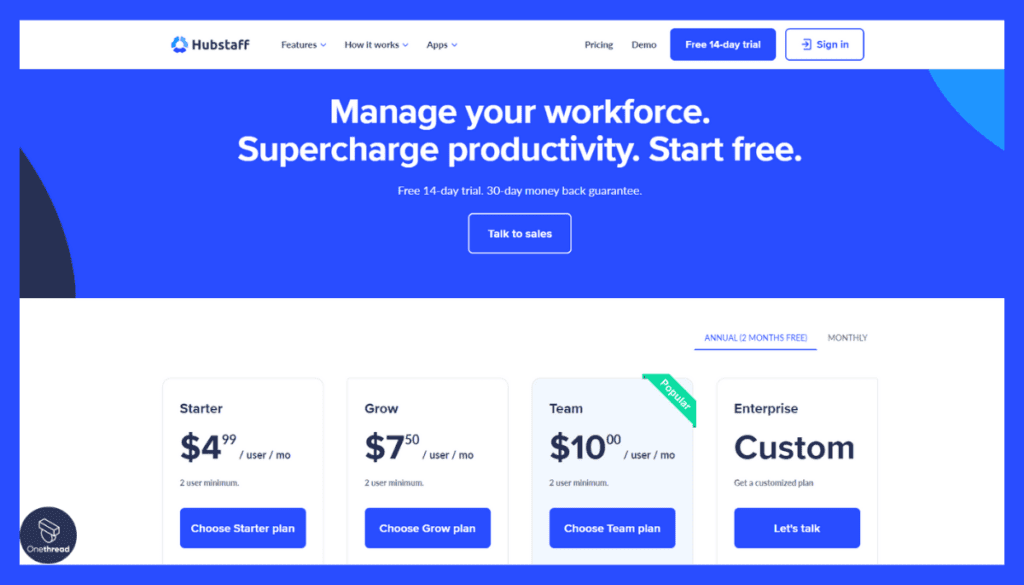
- Free: 0$/ User, Free of cost with basic features
- Premium: 4$/User, Advanced project with premium features
Other Alternatives to Hubstaff with Details
Hubstaff’s unique selling proposition lies in its comprehensive time-tracking capabilities, making it a favorite among remote and on-site teams.
Yet, this strength might not align with every project’s requirements, and some users may find themselves craving different functionalities or a more tailored experience.
Whether it’s the need for more customization, different pricing structures, or simply the allure of exploring new, innovative tools, the search for alternatives to Hubstaff is a natural progression.
Here’s a list of 9 other alternatives that may provide the answer to your project management needs:
Trello
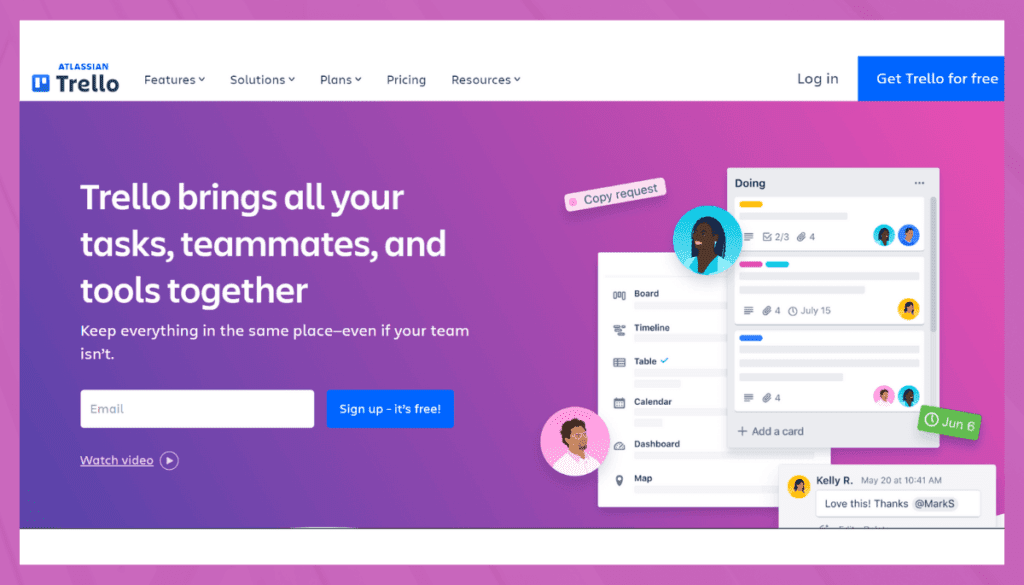
Trello is a popular project management tool known for its visual and intuitive approach to organizing tasks and projects. Founded in 2011, Trello utilizes a board-and-card system that mirrors a digital Kanban board, where individual tasks are represented as cards that can be dragged and dropped across different columns or “lists.”
Users create boards for specific projects and then add lists to represent different stages or categories. Cards, representing tasks, are moved across lists to denote progress.
Trello enhances collaboration, allows for easy tracking of progress, and integrates with various other tools.
Features of Trello
- Drag-and-Drop Task Management
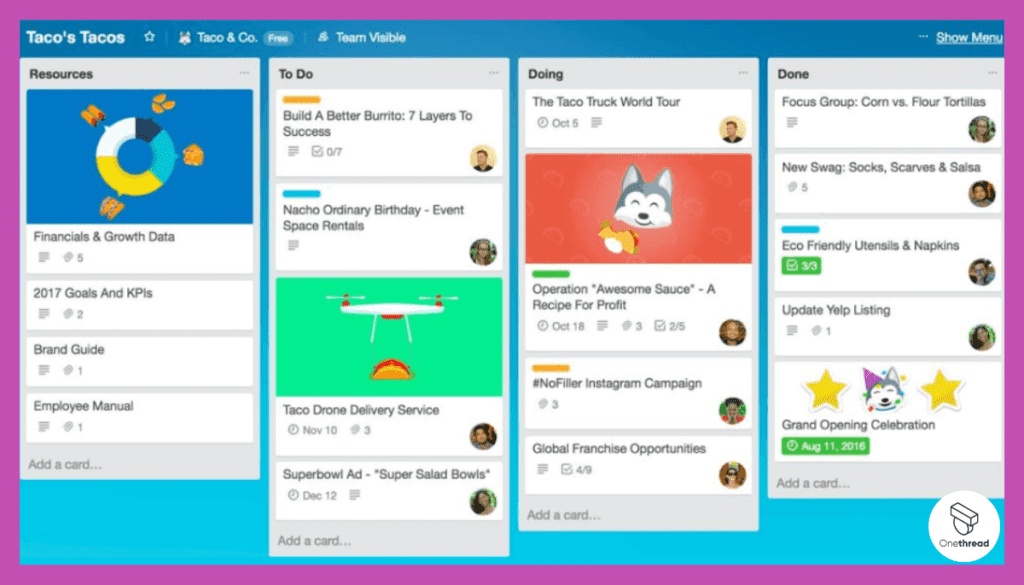
Trello boasts a highly intuitive drag-and-drop interface, which serves as its hallmark feature. This functionality empowers users to effortlessly relocate cards across lists or reorder them within a list. This tactile approach mirrors the way physical tasks are managed in the real world. By harnessing this natural interaction, Trello ensures that adapting and prioritizing tasks on-the-fly becomes an instinctive and seamless process.
- Seamless Collaboration and Information Sharing
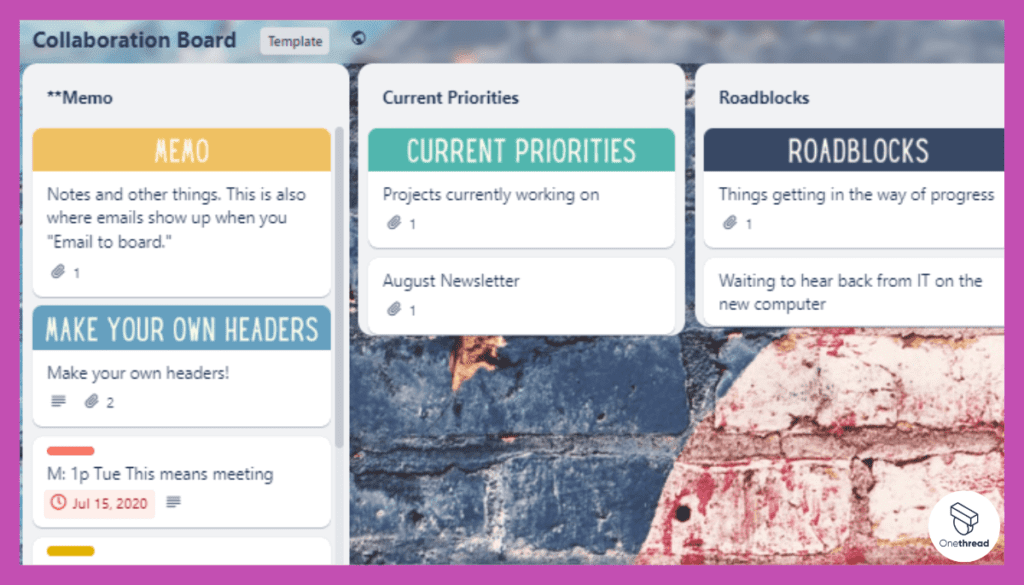
Central to Trello’s design philosophy is its emphasis on collaboration. Users can extend invitations to team members, granting them access to specific boards. This inclusivity allows team members to both observe and contribute to tasks. By nurturing this collaborative ecosystem, Trello encourages real-time communication, guaranteeing that everyone remains aligned and well-informed regarding the progress of tasks.
- Efficient Task Allocation and Deadlines
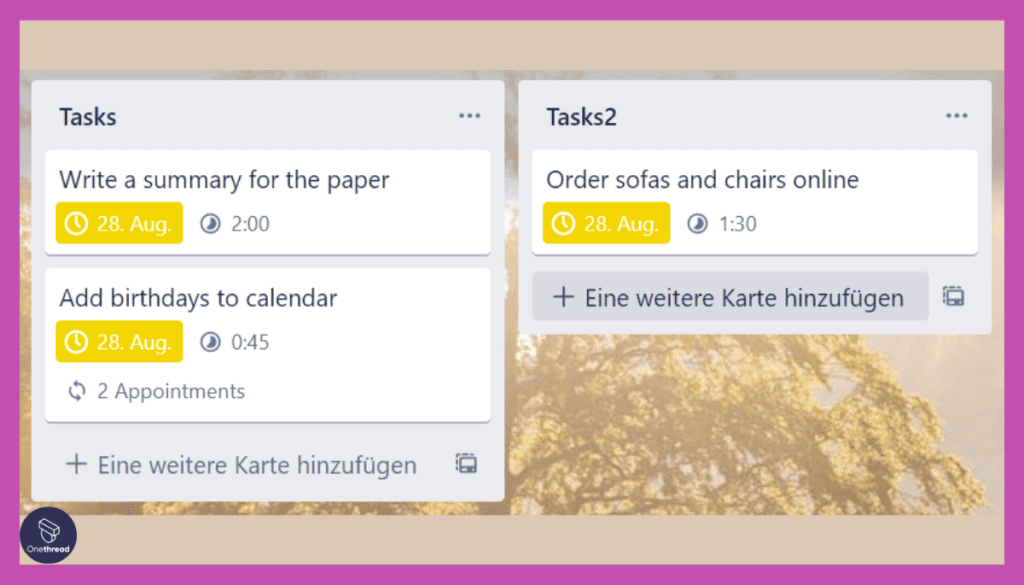
Trello simplifies accountability through its feature of assigning cards to designated team members. This facet enhances task ownership, as each card is linked to an individual responsible for its completion. Moreover, users can establish due dates, instilling a sense of urgency that promotes timely task execution. This functionality assists in effectively prioritizing work and ensuring deadlines are met.
- Streamlined Task Classification with Labels and Categories
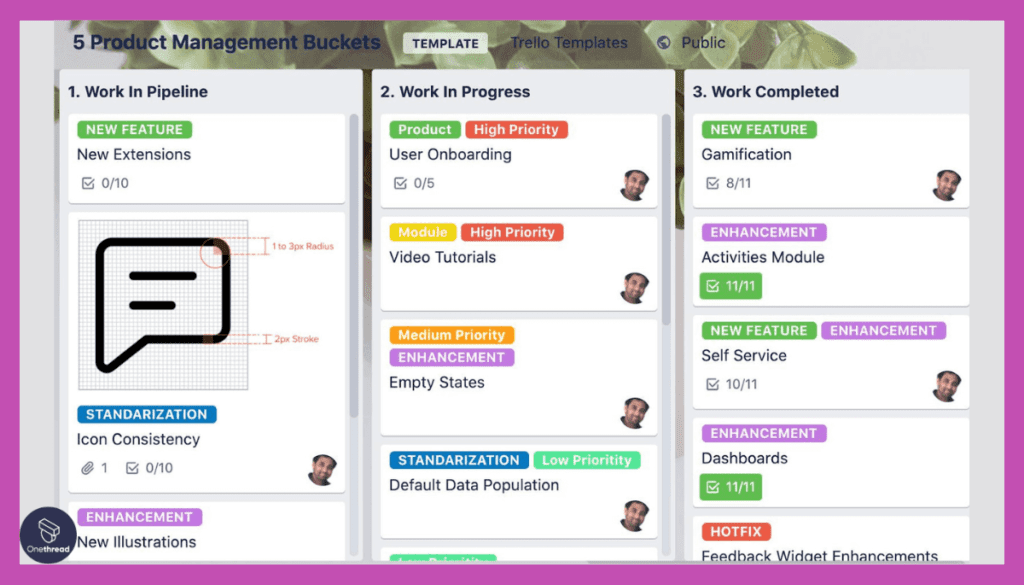
The ability to apply labels to cards provides a structured way to categorize and visually distinguish tasks. Custom labels can be tailored to denote diverse attributes like task urgency, nature, or department. This aspect considerably enhances task identification and sorting, proving especially beneficial for managing intricate workflows that encompass a multitude of tasks.
- Comprehensive Task Management with Attachments and Checklists
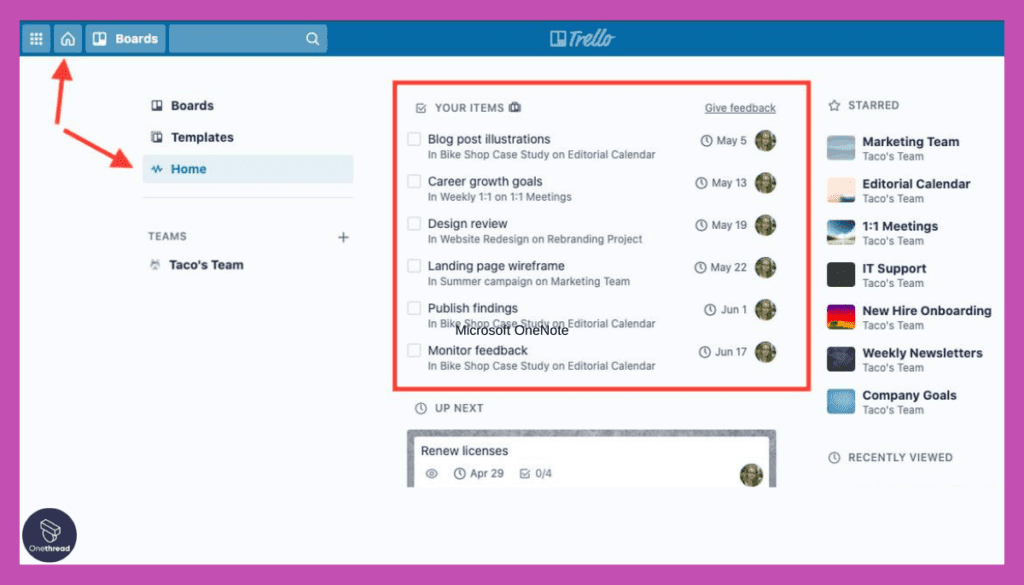
Trello facilitates comprehensive task management through its attachments and checklists features. Attachments allow users to directly link files, documents, and pertinent links to cards, creating a centralized repository of relevant information. Meanwhile, checklists are pivotal for breaking down complex tasks into manageable sub-tasks, imparting a lucid roadmap that guides the path to task completion.
Pros and Cons
Pros:
- Trello’s utilization of cards offers a vivid and intuitive depiction of tasks and project progress.
- Trello’s interface is designed with user-friendliness in mind, ensuring that individuals can swiftly adopt and navigate the platform.
- Its compatibility with integration options extends its functionality beyond its core features.
Cons
- Lacks a native time tracking feature, necessitating the use of third-party solutions for those requiring detailed time monitoring.
Customer Ratings
- G2: 4.4 (13,352+ reviews)
- Capterra: 4.5 (22,681+ reviews)
Pricing
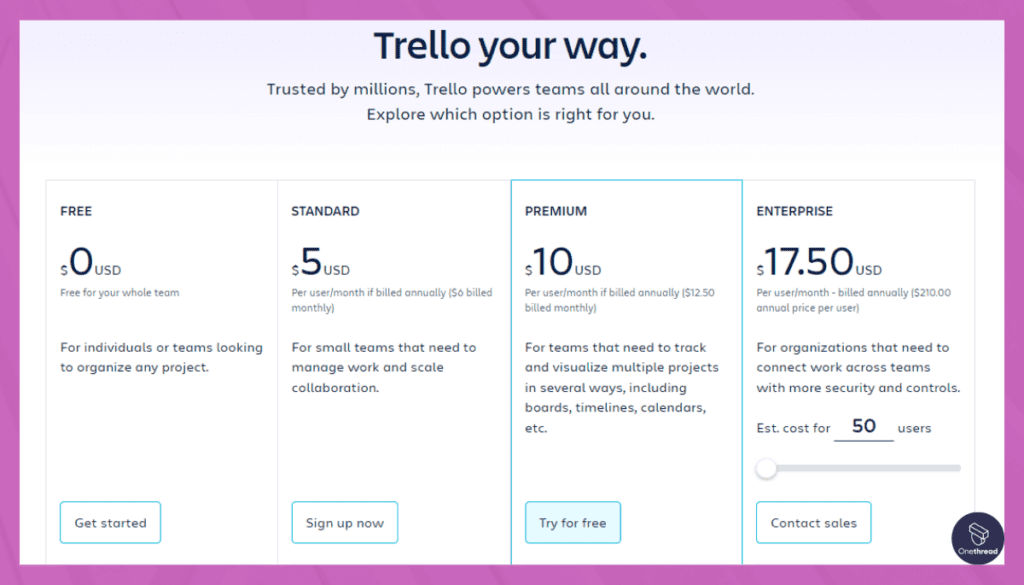
- Free Plan: Limited boards and basic features.
- Business Class: $10 per user/month, unlimited boards, and premium features.
- Enterprise: Custom pricing for large organizations, with advanced security and support.
Is Trello Better than Hubstaff?
Trello excels in visual task management and collaboration, whereas Hubstaff focuses more on time-tracking and productivity. Choosing one over the other depends on your specific needs and priorities.
Trello may be a better choice for visually driven teams seeking flexibility in project organization.
Our Review of Trello
Trello’s strengths lie in its simplicity and versatility. Its visual approach to project management allows teams to quickly grasp project statuses and collaborate effectively.
While it might lack some of the in-depth reporting features found in other tools, its user-friendly design and broad integration capabilities make it a solid choice for many teams.
Whether you’re a small startup or a large corporation, Trello’s adaptable nature could be a winning fit for your project management toolkit.
Asana
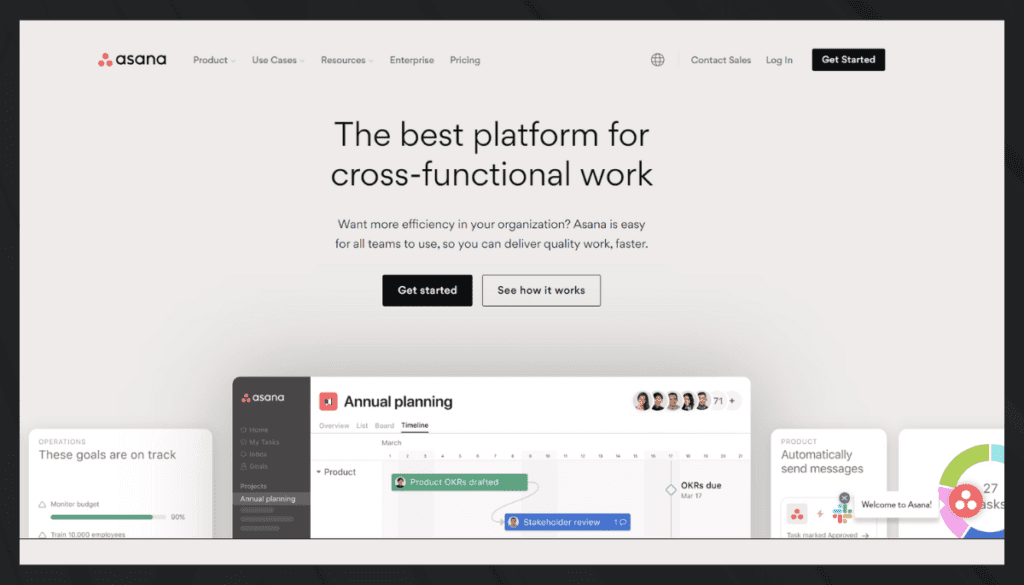
Asana is a widely-used project management platform that streamlines team collaboration, task management, and workflow automation. Since its founding in 2008, Asana has been focused on enhancing teamwork and productivity within organizations of all sizes.
Asana allows teams to create projects, assign tasks, set deadlines, and track progress. Tasks can be organized into boards, lists, or timelines, and users can add comments, attachments, and custom fields.
Asana enhances transparency, facilitates communication, supports integrations with various tools, and offers customizable workflows.
Features of Asana
- Timeline Visualization and Calendar Insights
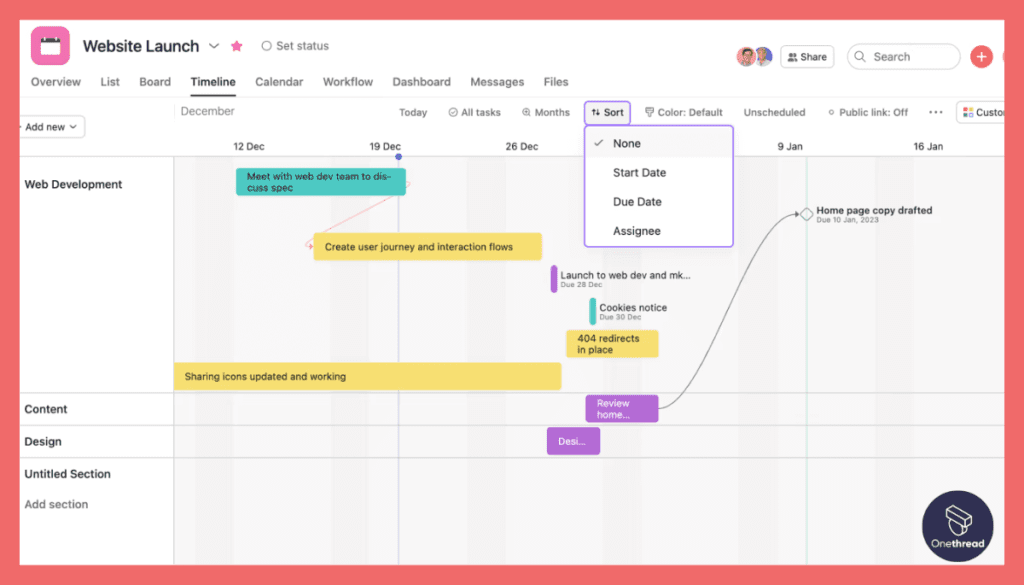
Asana’s Timeline view introduces a dynamic visual facet to task management. By presenting tasks on a timeline akin to a Gantt chart, it exposes task dependencies and deadlines. This transformative feature equips teams with the ability to anticipate project durations, optimize resource allocation, and proficiently oversee interconnected tasks. Complementing this, the Calendar view furnishes a comprehensive monthly outlook, facilitating meticulous task and appointment scheduling.
- Seamless Task Coordination and Priority Setting
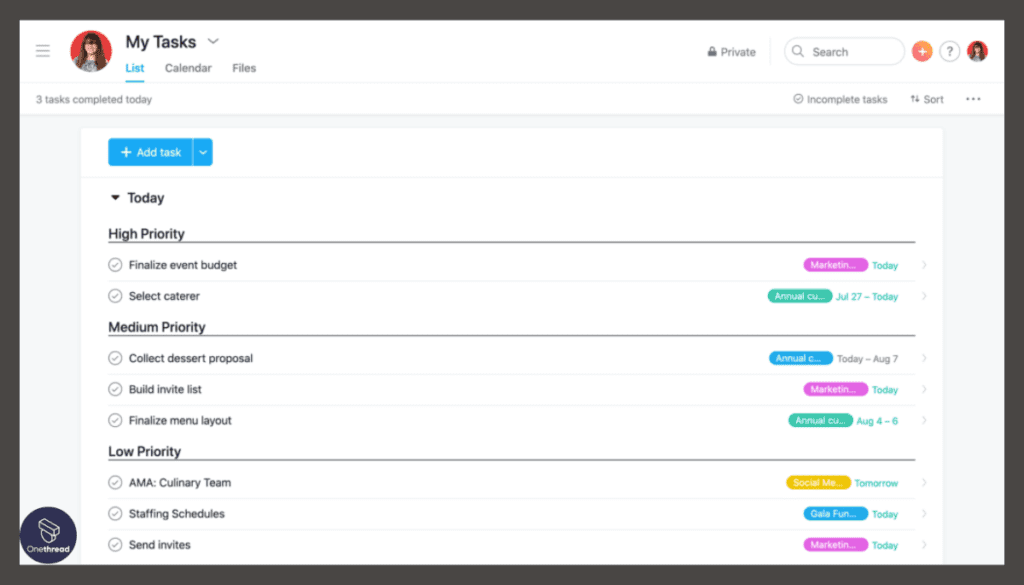
The intricacies of managing intricate workflows are effortlessly navigated through Asana’s task dependencies. By establishing logical connections between tasks, the platform ensures an organized sequence of execution. Simultaneously, priority management is facilitated through the strategic utilization of due dates and the innovative implementation of Custom Fields. This intricate interplay enables teams to classify tasks according to a diverse array of attributes.
- Personalized Task Attributes with Custom Fields and Tags
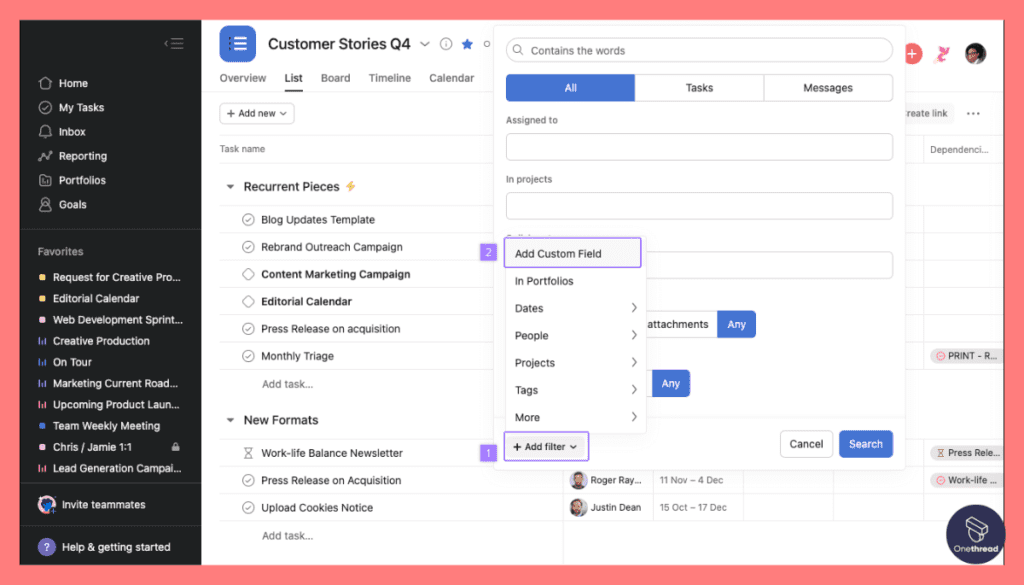
Asana’s ingenious inclusion of Custom Fields imparts a newfound adaptability to tasks. Users can meticulously define and populate custom fields with specialized information, essentially transforming tasks into unique data repositories. In parallel, Tags introduce an additional tier of task categorization, enabling tasks to be conglomerated across various projects based on shared characteristics.
- Enhanced Collaboration and Contextual Communication
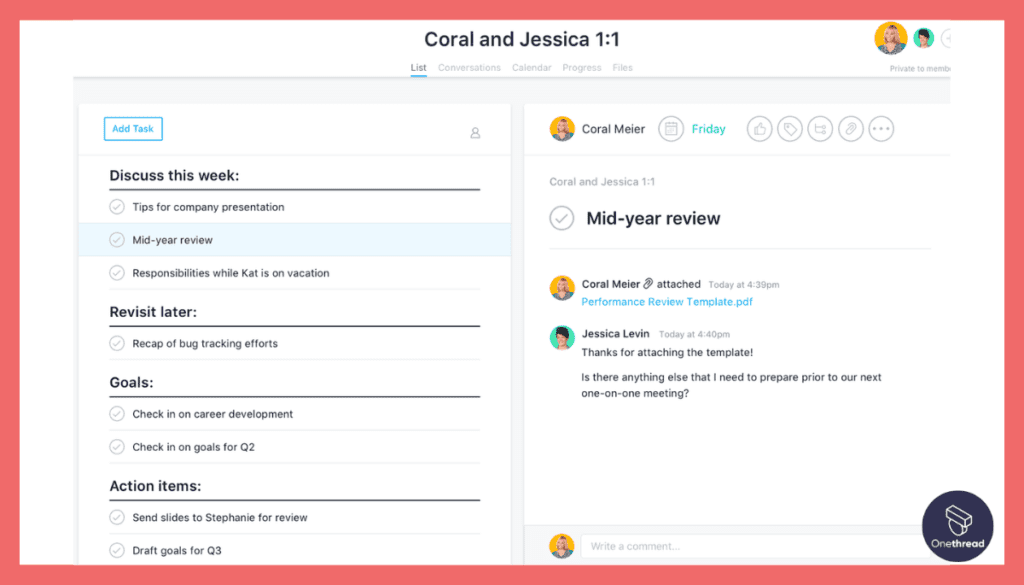
At the heart of Asana’s triumph lies its prowess in nurturing collaborative efforts. Task-centric discussions flourish through interactive comments and seamlessly integrated attachments, fostering contextual conversations. The introduction of mentions efficiently alerts specific team members, augmenting the pace of communication. Moreover, task Followers are automatically kept abreast of modifications, ensuring a well-informed collective.
- Efficiency Amplification via Project Templates and Automation
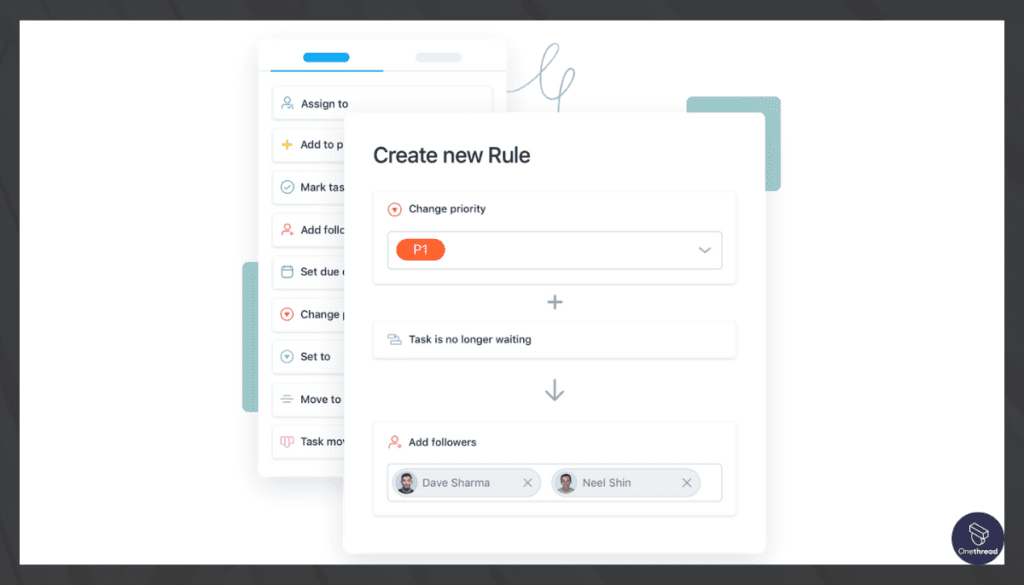
To expedite project initialization, Asana offers meticulously crafted Project Templates specifically tailored for prevalent workflows. These templates encompass pre-configured tasks, customizable fields, and strategically allocated due dates, alleviating the burden of manual setup.
Furthermore, the Automation component streamlines the execution of repetitive tasks by autonomously triggering actions based on designated stimuli. This orchestrated synergy maintains operational consistency and propels efficiency forward.
Pros and Cons
Pros:
- Asana excels in providing versatile tools for organizing, tracking, and prioritizing tasks.
- The inclusion of the Timeline view significantly enhances project scheduling capabilities.
- Asana’s Calendar view offers a pragmatic overview of tasks
Cons:
- The availability of advanced features within Asana necessitates a paid subscription.
Customer Ratings
- G2: 4.3 (9,446+ reviews)
- Capterra: 4.5 (22,681 reviews)
Pricing
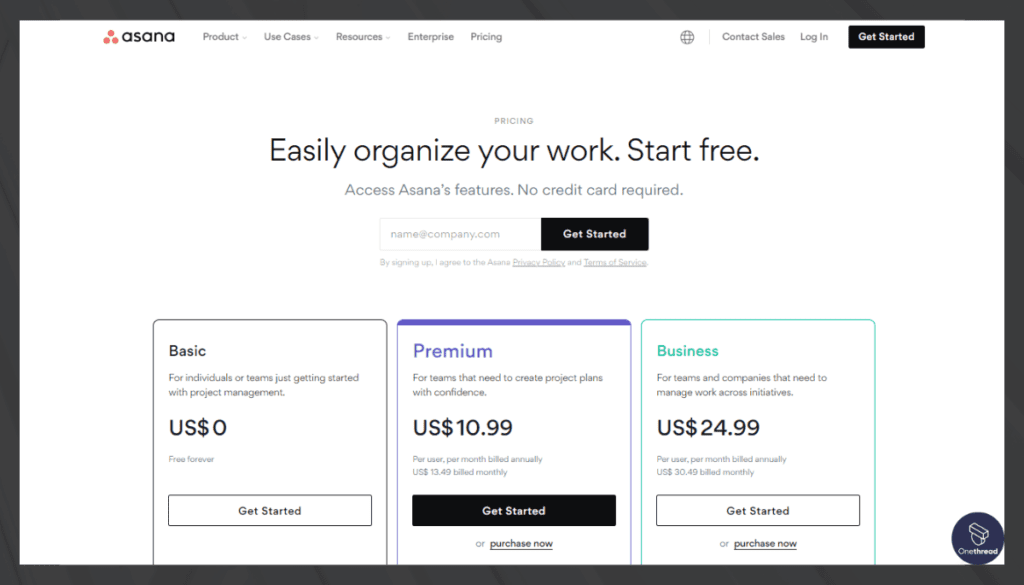
- Basic Plan: Free, limited functionality for individuals or small teams.
- Premium Plan: $13.49 per user/month, expanded features and customization.
- Business Plan: $30.49 per user/month, advanced integrations and security.
- Enterprise Plan: Custom pricing for large organizations, with dedicated support.
Is Asana Better than Hubstaff?
Asana’s strengths lie in collaboration, flexibility, and ease of use, whereas Hubstaff is more focused on traditional project scheduling.
If your team prioritizes visual task management, seamless communication, and integrations, Asana may be the better choice.
Our Review of Asana
Asana stands out as a powerful yet user-friendly tool that can adapt to diverse project management needs. Its versatile design, rich feature set, and robust integration capabilities make it a strong contender in the project management space.
Although some may find its pricing a bit steep for advanced features, the overall value it offers in fostering collaboration and efficiency makes it a worthwhile investment for many teams.
Whether you’re a freelancer, small business, or large corporation, Asana’s flexibility can cater to your unique project demands.
Time Doctor
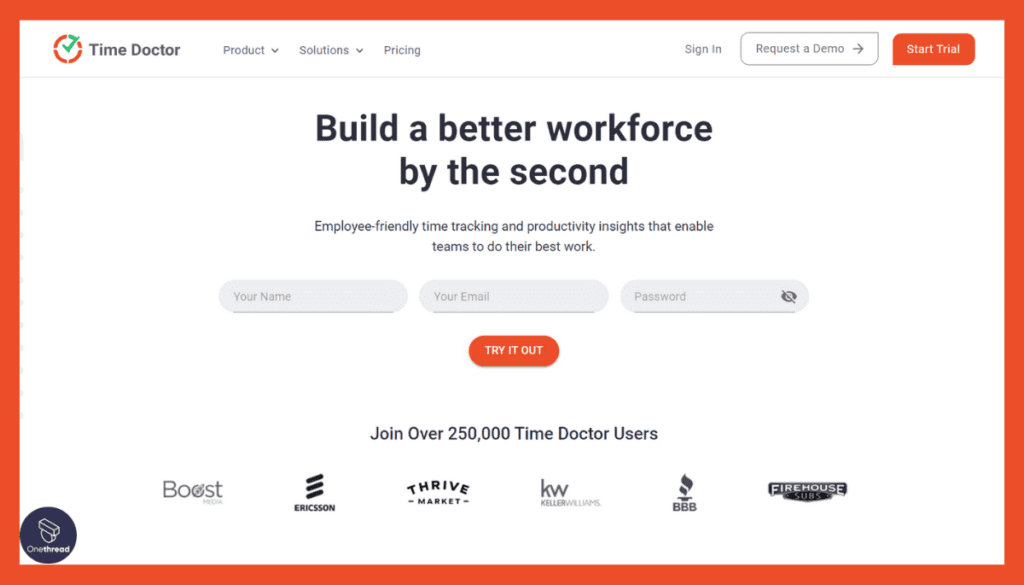
Time Doctor is a comprehensive time tracking and productivity monitoring tool. Founded in 2010, it’s designed to help teams and individuals track work hours, enhance productivity, and manage projects more efficiently.
Time Doctor records active work time, breaks, and idle time. Users can track time spent on tasks, websites, and applications, generating detailed reports for analysis.
It provides insights into individual and team performance, facilitates client billing, ensures accountability, and helps identify productivity bottlenecks. It’s adaptable across various industries, including remote teams, freelancers, and organizations of all sizes.
Features of Time Doctor
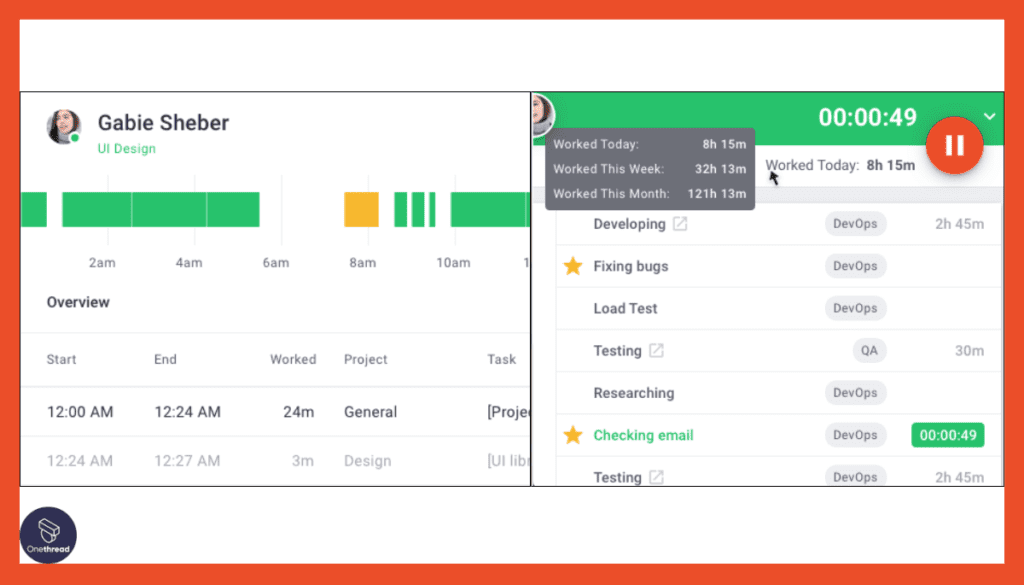
- Time Tracking and Monitoring
Time Doctor offers comprehensive time tracking capabilities, allowing users to accurately record the time spent on tasks and projects. It tracks both active and idle time, providing insights into work patterns and productivity gaps.
Time tracking is not limited to manual input; Time Doctor also offers automated tracking options through desktop and mobile apps. This feature ensures that work time is accurately logged, even if users forget to start or stop the timer.
2. Detailed Timesheets
Time Doctor generates detailed timesheets that provide a clear breakdown of the time spent on various tasks and projects. These timesheets offer a visual representation of work hours, making it easy to review and analyze how time is allocated.
Each timesheet typically includes information such as task descriptions, time intervals, and any breaks taken. This level of detail is useful for evaluating productivity, tracking progress, and optimizing time management strategies.
3. Project and Task Management
Time Doctor allows users to organize their work by creating projects and tasks. This feature facilitates better project management and helps teams allocate time effectively. Users can assign time to specific tasks and projects, allowing for accurate tracking and reporting.
By categorizing work into projects and tasks, teams gain insights into where their time is being invested, enabling better resource allocation and improved decision-making.
4. Productivity Analytics
Time Doctor offers productivity analytics that provide a comprehensive overview of individual and team performance. These analytics include data on time spent on tasks, websites visited, and application usage.
These insights allow users to identify areas of improvement, optimize workflows, and address time-wasting activities. Managers can also use these analytics to measure employee productivity and assess team efficiency.
5. Distraction Management
Time Doctor includes features to manage distractions and maintain focus during work hours. Users can set up alerts for excessive time spent on specific websites or applications, helping them stay on track and minimize distractions.
Additionally, the software provides a “Focus Mode,” which blocks distracting websites and applications for a predetermined period. This feature encourages concentrated work sessions and improved productivity.
Pros and Cons
Pros:
- Time Doctor provides precise time tracking, capturing both active and idle time.
- Enables users to organize work through projects and tasks, enhancing task management and allocation of time.
- Integrates with popular project management and communication tools
Cons:
- Some users might have concerns about the level of monitoring involved in time tracking
Customer Ratings:
- G2: 4.4 (364+ reviews)
- Capterra: 4.6 (502+ reviews)
Pricing
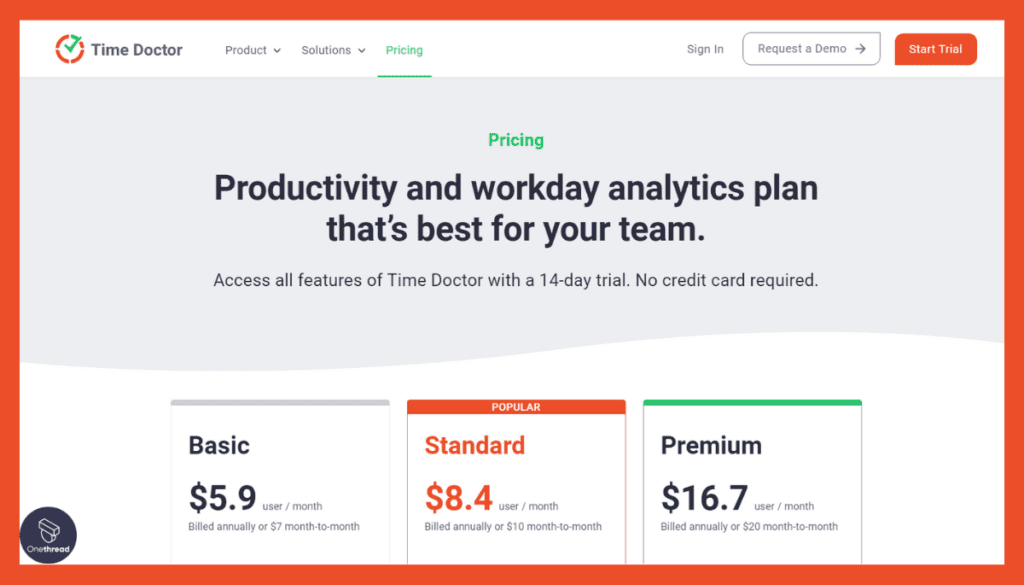
- Basic Plan: $7 per user/month, core time tracking features.
- Standard Plan: $10 per user/month, includes integrations and additional reporting.
- Premium Plan: $20 per user/month, with client access, concierge setup, and more.
Is Time Doctor Better than Hubstaff?
Time Doctor and Hubstaff cater to different needs. Time Doctor focuses on time tracking and productivity insights, whereas Hubstaff is geared towards traditional project scheduling.
Time Doctor may be a better choice for those specifically looking to monitor work hours and productivity.
Our Review of Time Doctor
Time Doctor excels in providing in-depth insights into how work hours are spent, making it an invaluable tool for organizations keen on enhancing productivity.
While it may not offer extensive project management functionalities like some competitors, its focus on time tracking is executed exceptionally well. For those aiming to understand and optimize their time usage, Time Doctor presents a strong and reliable solution.
JIRA
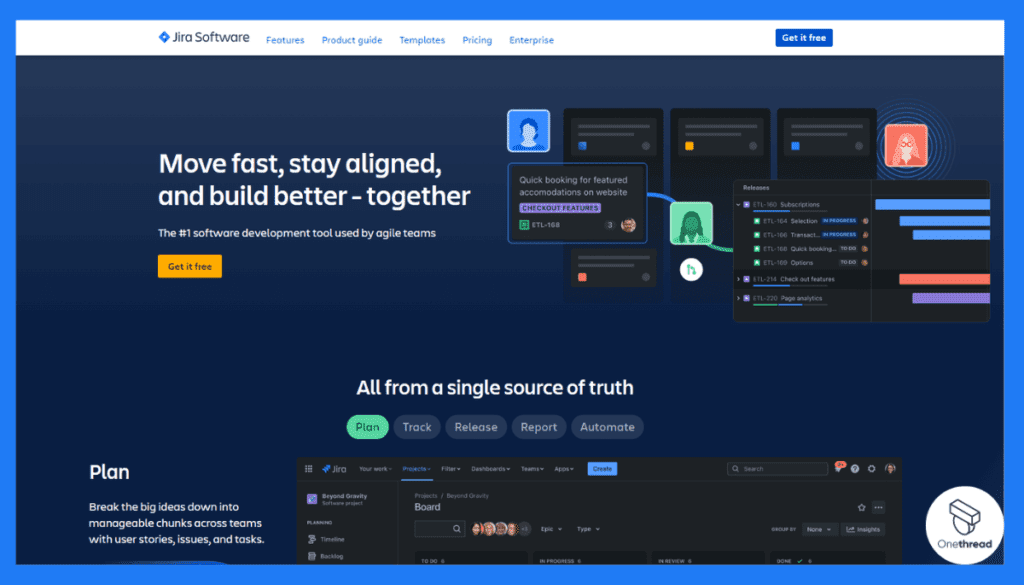
JIRA, created by Atlassian, is a powerful project management tool primarily tailored for agile development teams. Since its inception in 2002, JIRA has become a go-to solution for managing, tracking, and optimizing software development processes.
JIRA allows teams to create and track user stories, issues, and tasks. It offers various views like Scrum and Kanban boards, Gantt charts, and detailed reporting.
JIRA supports all major agile methodologies, enhances collaboration, offers robust integrations, and provides customizable workflows to align with specific development cycles.
Features of JIRA
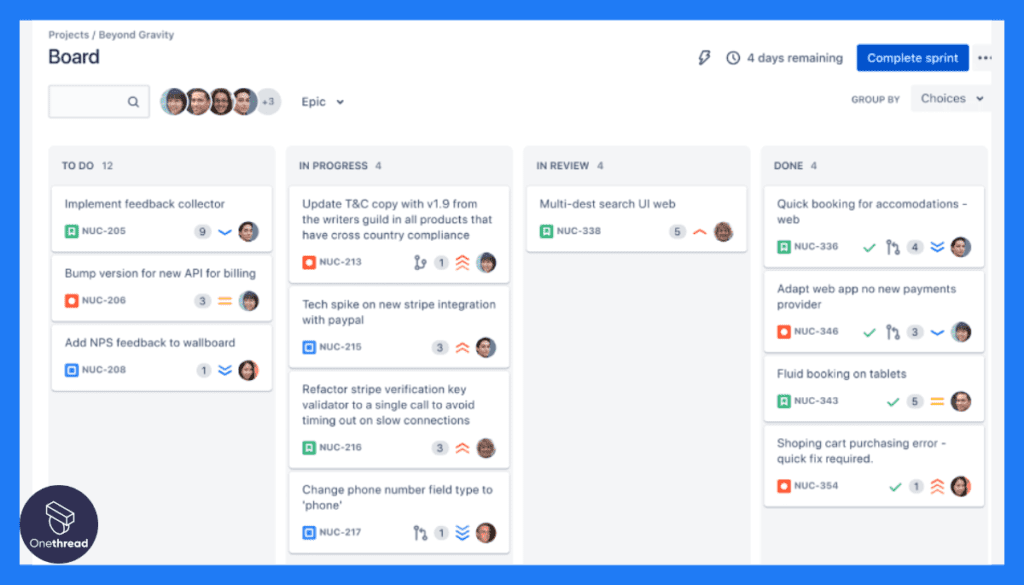
- Agile Project Boards
JIRA provides robust support for Agile methodologies through its dynamic Scrum and Kanban boards. These boards offer visually interactive representations of tasks and work items, allowing teams to monitor progress in real-time. Scrum boards effectively manage sprint cycles, while Kanban boards offer a seamless continuous flow perspective, assisting teams in optimizing work management.
- Strategic Roadmaps
The inclusion of roadmaps within JIRA empowers teams to meticulously plan and communicate project timelines. This feature enables the creation of visual timelines that vividly illustrate the evolution of epics and tasks over time. By presenting a clear trajectory of project milestones, roadmaps enhance stakeholder comprehension and anticipation of project outcomes.
- Seamless Integration with Development Tools
JIRA seamlessly integrates with prominent development tools such as Bitbucket and GitHub. This integration harmoniously links development processes with project management endeavors. Developers gain the ability to interlink code commits, branches, and pull requests with JIRA issues, cultivating an environment of transparency and cooperative synergy.
- Advanced Analytical Reporting
JIRA’s advanced reporting functionalities equip teams with the means to craft a diverse array of reports for in-depth project analysis. These reports encompass diverse metrics including burndown charts, velocity metrics, issue distribution insights, and more. These data-driven revelations empower teams to discern trends, closely monitor progression, and adeptly steer decision-making.
- Tailored Dashboards for Custom Insights
Within JIRA, users have the creative freedom to establish custom dashboards that present pertinent project insights. These personalized dashboards can amalgamate an assortment of gadgets such as graphical representations, issue catalogues, and filters. By assembling these components, users are granted an up-to-the-minute snapshot of project status and pivotal metrics.
Pros and Cons
Pros:
- JIRA stands out for its exceptional capability in effectively tracking and managing issues and tasks across projects.
- JIRA’s strength lies in its adaptable workflows that can be customized to perfectly align with your team’s unique processes.
- The inclusion of Scrum and Kanban boards provides an exceptional advantage in visualizing.
Cons:
- JIRA’s extensive feature set might be excessive for smaller projects or teams.
Customer Ratings
- G2: 4.3 (5,442+ reviews)
- Capterra: 4.4 (13,241+ reviews)
Pricing
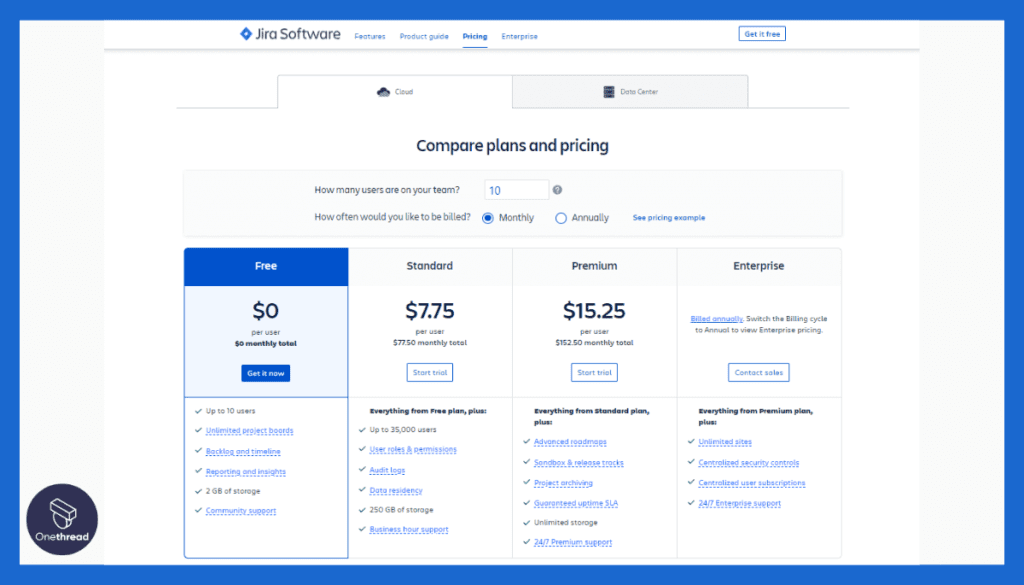
- Free Plan: For small teams, with basic functionalities.
- Standard Plan: $7 per user/month, increased project and user capacity.
- Premium Plan: $14 per user/month, advanced features, and 24/7 support.
- Enterprise Plan: Custom pricing for large organizations, with enhanced security and support.
Is JIRA Better than Hubstaff?
JIRA and Hubstaff serve different niches. JIRA is geared towards agile development with rich customization, while Hubstaff focuses on traditional project management and scheduling.
If agile methodologies and intricate development workflows are a priority, JIRA is likely a better choice.
Our Review of JIRA
JIRA stands as a comprehensive solution for software development teams seeking to embrace agile practices. Its extensive feature set, customization abilities, and integration options make it a formidable tool in the development landscape.
For organizations committed to agile principles and seeking a tool that can grow and adapt with them, JIRA presents a compelling and proven choice.
Its reputation as a leader in the development project management sphere is well-deserved and continues to be a driving force in the industry.
Monday.com
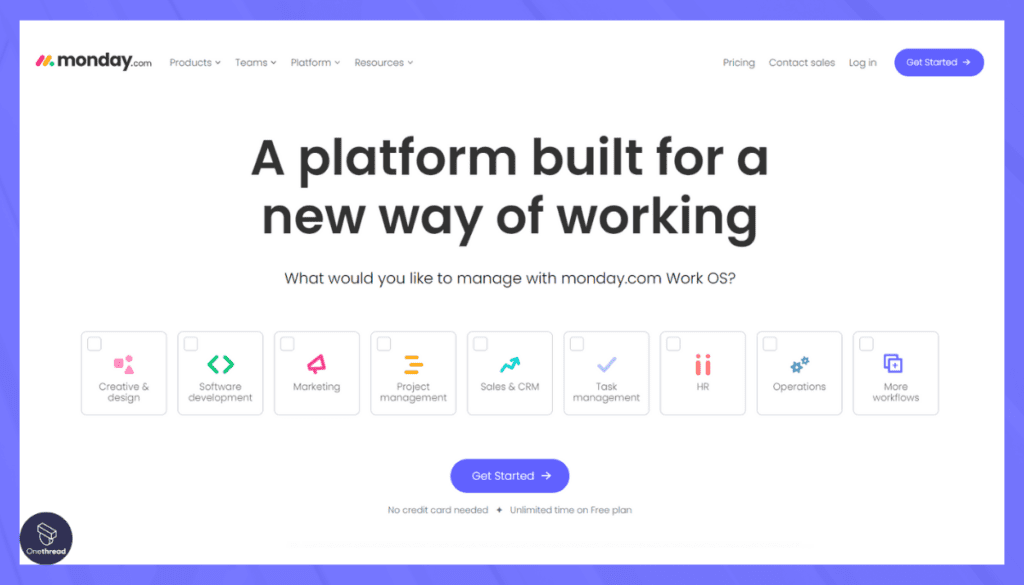
Monday.com, founded in 2012, is a flexible platform designed to simplify the way teams work together. It’s utilized by various organizations to manage tasks, projects, and workflows.
Users can create boards to organize tasks, set timelines, assign responsibilities, and track progress. The platform is highly customizable, allowing teams to design workflows that align with their specific needs.
Monday.com fosters collaboration, enhances visibility across projects, and integrates with a multitude of tools, providing a unified workspace.
Features of Monday.com
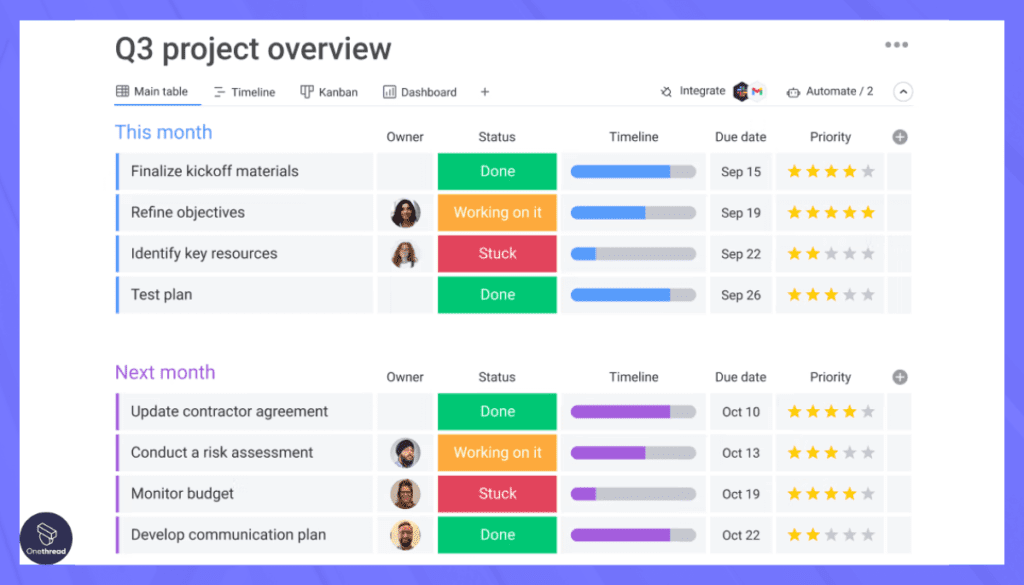
- Visualized Work Management
A standout feature of Monday.com is its visually intuitive work management approach. The foundation is constructed upon dynamic Boards that vividly represent projects, tasks, or processes. Within these Boards, Items are created to encapsulate various forms of work, be it tasks or full-fledged projects. This visual framework ensures a quick grasp of project structure and progress with just a glance.
- Flexible Workflow Customization
Monday.com excels in adapting to diverse workflows. The backbone of each Board comprises Columns, which can be tailored to mirror various attributes or work stages. This adaptability empowers teams to configure the platform according to their specific requirements, making it seamlessly adaptable to a wide range of project types.
- Streamlined Automation
An exemplary feature of Monday.com is its Automation capabilities. By setting triggers and actions based on defined conditions, teams can automate recurring processes, significantly reducing manual workload and maintaining uniformity in workflow execution.
- Emphasized Collaboration and Communication
Collaboration is at the core of Monday.com’s design philosophy. Assigning Items to team members, tagging colleagues using “@” mentions, and initiating discussions within the platform are all streamlined processes. The Updates section ensures that the entire team stays informed about task and project changes, progress, and dialogues.
- Visualized Timeline and Calendar
Monday.com’s Timeline view offers a visual portrayal of tasks and projects across time, granting insights into task interdependencies, timelines, and critical milestones—akin to the functionality of a Gantt chart. Simultaneously, the Calendar view offers a lucid monthly overview of tasks, facilitating seamless work planning and allocation.
Pros and Cons
Pros:
- Monday.com’s visual approach makes comprehending projects and tracking progress effortless.
- The platform’s automation capabilities handle repetitive tasks, amplifying efficiency and upholding uniformity.
- Monday.com’s Timeline view and calendar enrich project planning and scheduling by offering a visual representation.
Cons:
- Extensive range of options within Monday.com might be daunting for simpler projects
Customer Ratings
- G2: 4.7 (8,523+ reviews)
- Capterra: 4.6 (4,099+ reviews)
Pricing
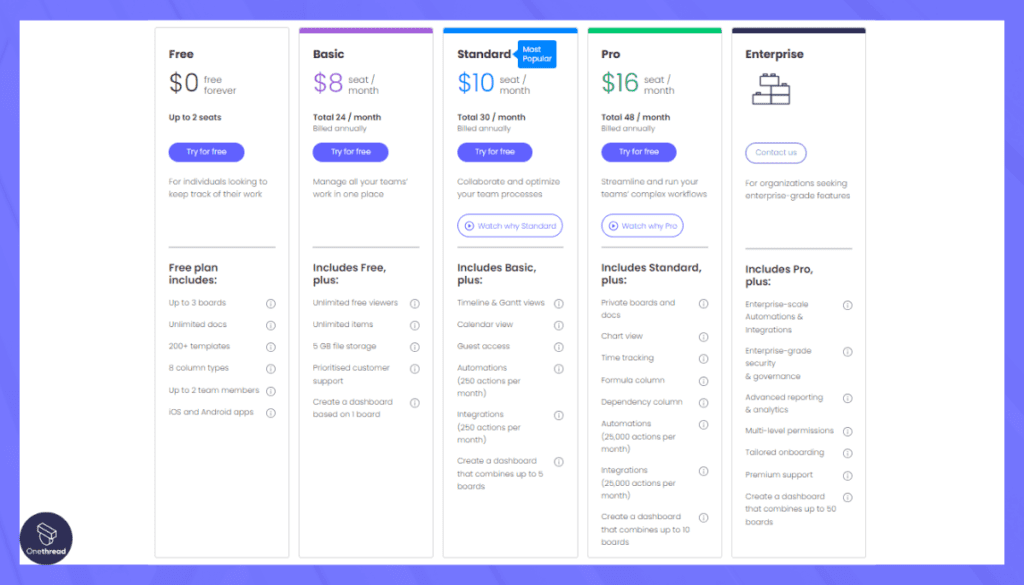
- Free
- Basic: $8/seat/month
- Standard: $10/seat/month
- Pro: $16/seat/month
- Enterprise: Custom pricing
Is Monday.com Better than Hubstaff?
Monday.com offers a more versatile and visually engaging approach to project management compared to Hubstaff. If collaboration, customization, and integration with other tools are important to your team, Monday.com may be the more suitable choice.
Our Review of Monday.com
Monday.com is a refreshing and dynamic tool that can transform the way teams work. Its blend of functionality and visual appeal sets it apart, making project management not only effective but enjoyable.
Whether you’re managing a small team or orchestrating complex projects across a large enterprise, Monday.com offers the flexibility and power to help you achieve your goals.
Wrike
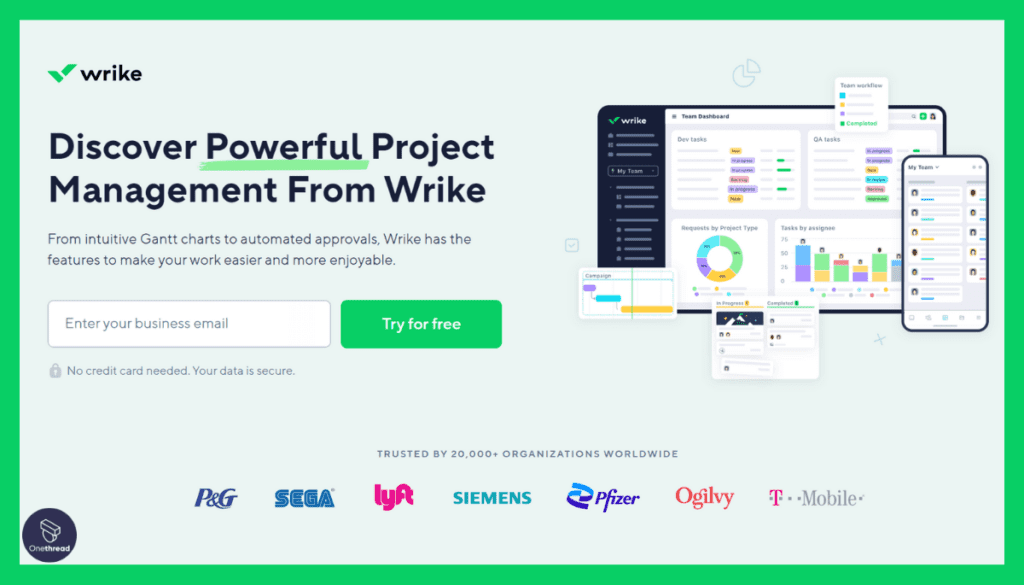
Wrike is an award-winning collaborative work management platform designed to streamline project planning, coordination, and execution. Founded in 2006, it caters to diverse teams seeking better alignment, efficiency, and visibility into their projects.
Wrike offers task and project management, time tracking, detailed reporting, and customizable dashboards. Teams can create, assign, and prioritize tasks while tracking progress through various view modes like Gantt charts, Kanban boards, or lists.
Features of Wrike
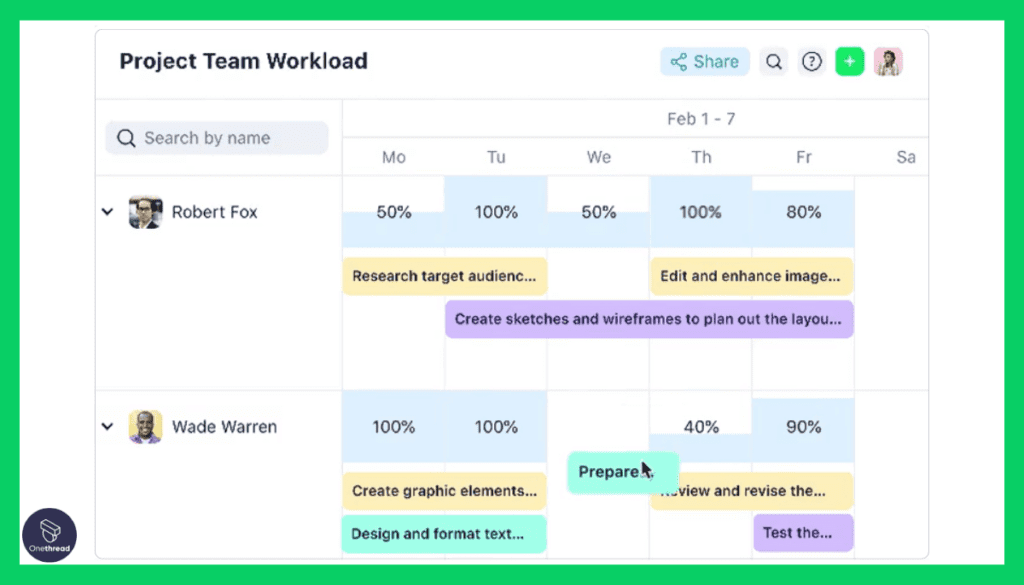
- Versatile Task and Project Management
Wrike offers a comprehensive solution for efficiently handling tasks and projects across a spectrum of complexities. The organizational hierarchy begins with Folders, acting as top-level units that house interconnected projects and tasks. Within each Project, the precision of task planning and execution is elevated. Tasks themselves are imbued with depth through detailed descriptions, due dates, and assigned team members, thereby fostering transparency in task ownership and fostering accountability.
- Tailored Workflows and Visual Boards
A distinct strength of Wrike lies in its adaptability to match the intricacies of your team’s unique workflows. Through Custom Workflows, the stages of tasks can be meticulously defined, mirroring the specific sequences of your processes. Boards introduce a visual layer of organization to task management. By delineating columns that represent distinct stages and adorning them with task cards, this visual paradigm simplifies the oversight of task progression and prioritization.
- Insightful Gantt Charts and Timeline View
Wrike facilitates complex project planning with interactive Gantt charts that artistically convey task interdependencies and project timelines. This tool empowers teams to discern the project’s architectural skeleton, pinpoint potential bottlenecks, and arrive at judicious scheduling decisions. The Timeline view complements this by unfolding a chronological panorama of tasks, thereby aiding in the allocation of resources and project scheduling.
- Enhanced Collaboration and Contextual Communication
Collaboration is woven into Wrike’s fabric through a series of features. Task Discussions enable seamless communication within tasks, weaving conversations intricately with the work at hand. File attachments within tasks centralize project documents, fostering a hub of information. Meanwhile, mentions and notifications serve as an alert system, ensuring pertinent parties are promptly notified of updates and comments.
- Streamlined Initiation with Request Forms
Wrike streamlines task inception through the implementation of Request Forms. Teams can submit standardized requests for fresh tasks or projects, systematically capturing crucial information and guaranteeing that projects commence with clear-cut requisites. This feature fosters uniformity, minimizing gaps in information and promoting a cohesive initiation process.
Pros and Cons
Pros:
- Wrike provides a rich toolkit catering to a wide array of project types
- Wrike’s adaptability shines through by accommodating team-specific processes
- The inclusion of task automation elevates efficiency by streamlining repetitive processes
Cons:
- Exploring the full spectrum of functionalities within Wrike might require an initial investment
Customer Ratings
- G2: 4.2 (3,466+ reviews)
- Capterra: 4.3 (2,441+ reviews)
Pricing
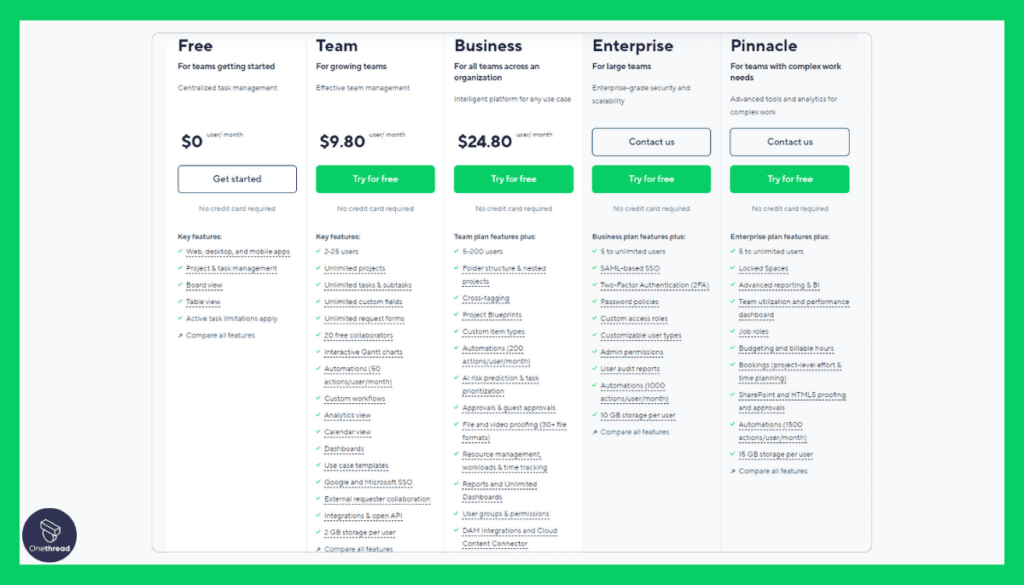
- Free Plan: Limited features for small teams.
- Professional Plan: $9.80 per user/month, full project planning, and collaboration tools.
- Business Plan: $24.80 per user/month, advanced customization, and reporting.
- Enterprise Plan: Custom pricing, tailored solutions, and advanced security.
Is Wrike Better than Hubstaff?
Wrike’s versatility, collaboration features, and robust integrations make it a different tool compared to Hubstaff. If you seek a comprehensive, customizable work management solution that aligns with modern collaboration needs, Wrike may be the better choice.
Our Review of Wrike
Wrike stands out as a well-rounded and sophisticated work management tool. Its blend of traditional project management capabilities with modern collaboration and customization features make it a robust solution for various team needs.
While it may take some time to fully exploit its extensive features, Wrike’s support and community resources assist in that journey.
Whether you need to manage simple tasks or complex cross-functional projects, Wrike’s flexibility, integration capabilities, and efficiency-enhancing tools make it a strong contender in the space.
ClickUp
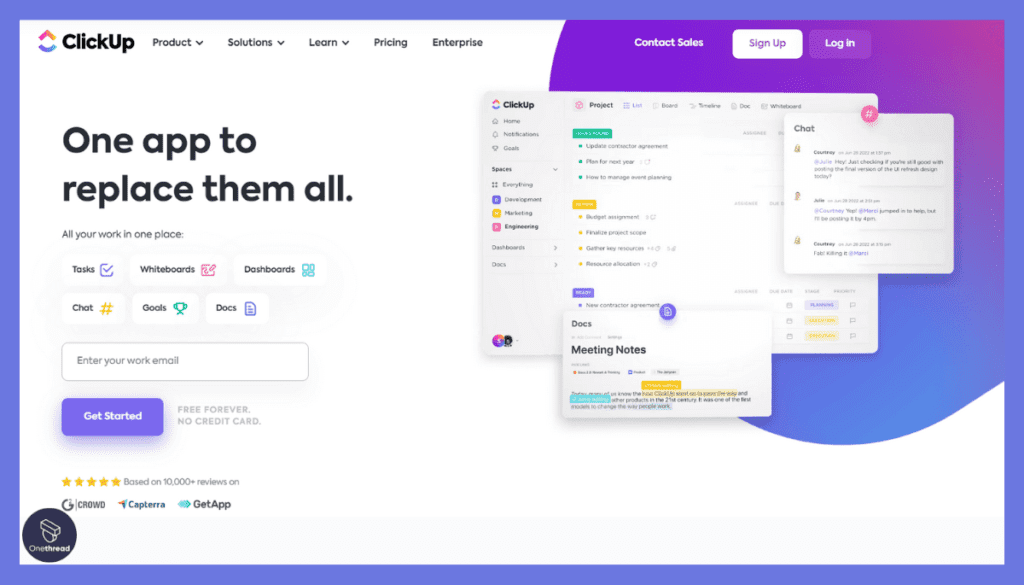
ClickUp, founded in 2017, is a versatile project management and productivity platform designed to replace other work apps. Its goal is to provide a centralized space where teams can plan, organize, and collaborate on their projects.
ClickUp offers powerful integrations, time tracking, automation, and adaptability to various workflows, fostering efficiency and alignment across teams.
Its flexibility makes it suitable for a wide range of industries, from marketing and design to development and remote work.
Features of ClickUp
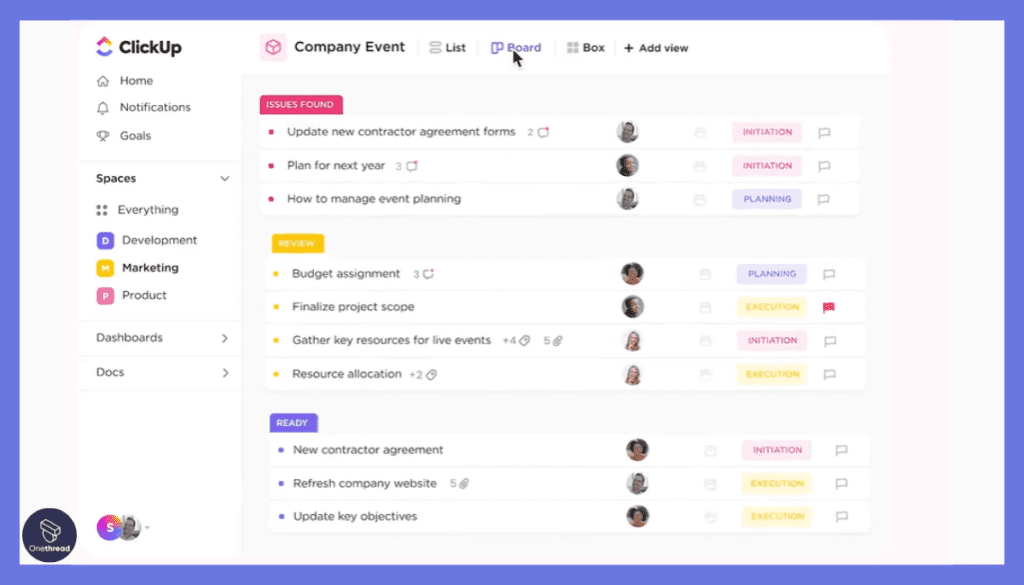
- Tailored Workflow Flexibility
ClickUp recognizes the unique nature of diverse projects and embraces customizable workflows. By allowing you to establish distinct stages through which tasks progress, ClickUp adapts seamlessly to your team’s specific processes. This adaptable structure fosters uniformity and transparency in the evolution of tasks.
- Efficient Time Tracking
ClickUp’s time tracking functionality empowers you to closely monitor task durations. This feature serves as a valuable tool for assessing task efficiency, evaluating resource allocation, and pinpointing areas where optimization can be implemented.
- Empowering Collaboration Tools
ClickUp places a strong emphasis on collaboration by facilitating direct discussions within tasks. Through the ability to mention colleagues in comments, team members remain informed, and threaded conversations ensure structured and contextually relevant communication.
- Centralized Document Management
Simplify your workflow by attaching files, documents, and images directly to tasks in ClickUp. This integrated feature serves as a hub for project-related materials, eliminating the need to navigate between tools for file sharing. It guarantees that essential information is accessible to all team members.
- Strategic Goals and OKRs
ClickUp’s Goals and OKRs feature plays a pivotal role in aligning team efforts with overarching objectives. This functionality enables you to define your goals, establish key results for measuring progress, and seamlessly track performance, all encapsulated within the ClickUp ecosystem.
Pros and Cons
Pros:
- ClickUp boasts an extensive array of features that effectively address a wide spectrum of project
- ClickUp’s prowess shines through its capacity to customize workflows and task statuses
- ClickUp manages to maintain an interface that is both intuitive and easily navigable
Cons:
- Some of ClickUp’s more advanced features are tied to higher-tier paid plans
Customer Ratings
- G2: 4.7 (8,543+ reviews)
- Capterra: 4.7 (3,755+ reviews)
Pricing
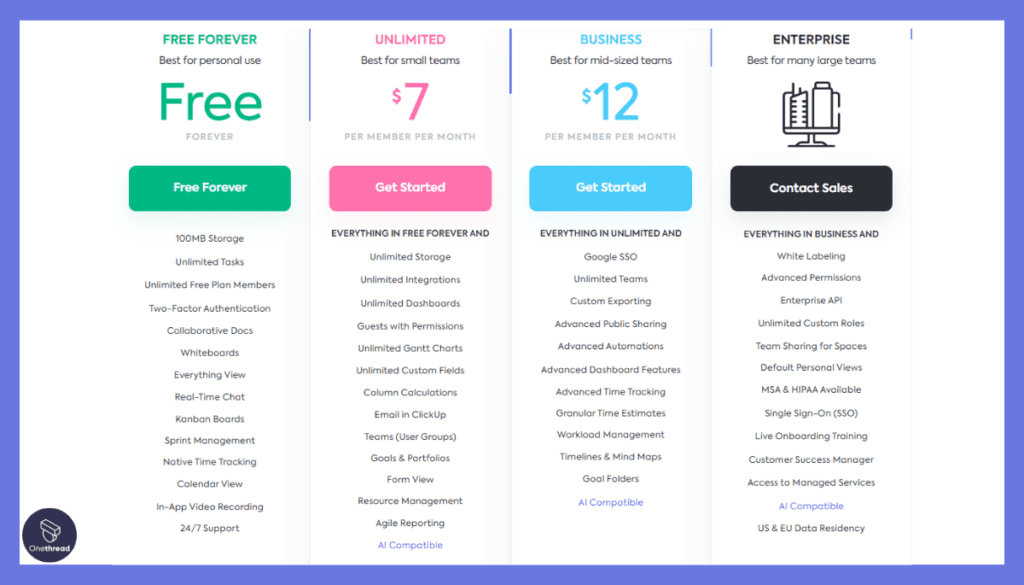
- Free Forever Plan: Limited features, suitable for small teams or personal use.
- Unlimited Plan: $5 per user/month, access to unlimited integrations and dashboards.
- Business Plan: $9 per user/month, advanced features, automation, and reporting.
- Enterprise Plan: Custom pricing, tailored solutions for larger organizations.
Is ClickUp Better than Hubstaff?
ClickUp’s modern design, collaboration features, and extensive customization make it distinct from Hubstaff. If a unified workspace that offers adaptability and a wide array of features is what you seek, ClickUp may be the preferable choice.
Our Review of ClickUp
ClickUp is a vibrant and forward-thinking tool that has made waves in the project management space. Its commitment to creating an all-in-one workspace resonates with teams seeking to minimize tool fragmentation.
The balance between functionality and usability is one of ClickUp’s strengths, allowing teams to create workflows that mirror their unique needs.
With competitive pricing and continuous updates, ClickUp showcases itself as an ambitious and dependable solution for modern project management. Its vision of streamlining work resonates with a wide audience, making it a promising option for various teams and industries.
Zoho Projects
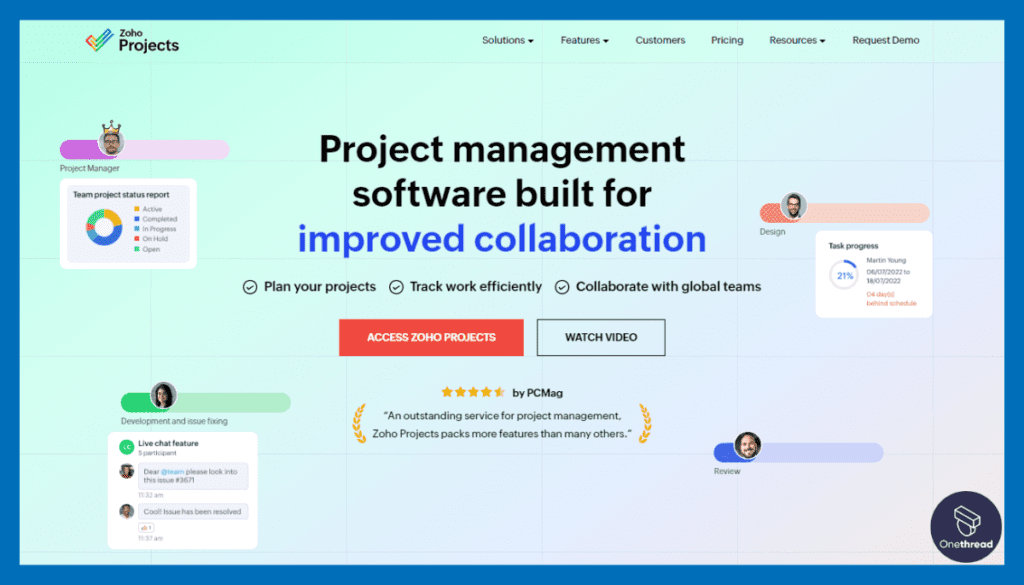
Zoho Projects, part of the Zoho suite, is a popular project management solution tailored to facilitate planning, tracking, and collaboration within teams. Since its launch in 2006, it has provided an efficient way to manage projects of various complexities.
Zoho Projects enables users to create projects, assign tasks, set deadlines, and monitor progress through various views like Gantt charts, Kanban boards, and reports. It also offers issue tracking and time logging features.
Features of Zoho Projects
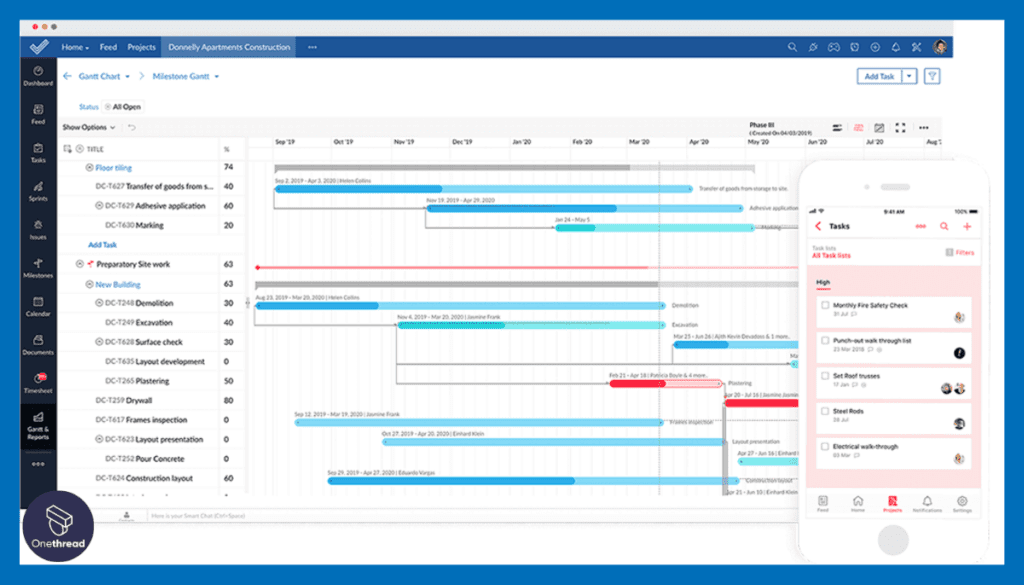
1. Task Management
Zoho Projects offers robust task management capabilities. You can create tasks, assign them to team members, set due dates, and track progress. Tasks can be organized into task lists or milestones, allowing for structured project planning.
Zoho Projects provides features like task dependencies, task hierarchy, and task priorities. These tools enable teams to manage complex workflows and ensure tasks are executed in the right sequence.
2. Gantt Charts
Gantt charts in Zoho Projects provide a visual representation of project timelines and task dependencies. This feature helps project managers and teams understand the project’s schedule, identify bottlenecks, and make informed scheduling decisions.
Gantt charts also allow for easy adjustments when changes occur, as the visual nature of the tool aids in understanding the impact of modifications on the project timeline.
3. Collaboration and Communication
Zoho Projects emphasizes collaboration by offering discussion forums, document sharing, and commenting features. Team members can engage in contextual conversations, share project-related files, and provide feedback directly within the platform.
Real-time collaboration tools ensure that team members remain connected and informed about project updates, enhancing communication efficiency.
4. Time Tracking and Reporting
Zoho Projects includes time tracking functionalities, allowing team members to log hours spent on tasks. This feature aids in evaluating task efficiency, project costs, and resource allocation. Time tracking data can be used to generate insightful reports for analysis.
The platform also provides various project reports, including task reports, timesheet reports, and progress reports. These reports offer valuable insights into project performance, aiding decision-making.
5. Issue Tracking
Zoho Projects offers issue tracking capabilities, enabling teams to report, track, and resolve project-related issues or bugs. Issues can be assigned, prioritized, and resolved within the platform, ensuring that project progress remains unhindered by obstacles.
Pros and Cons
Pros:
- Zoho Projects excels in providing tools for creating, assigning, and tracking tasks
- The platform offers Gantt charts for visualizing project timelines and dependencies, aiding in planning and decision-making
- Zoho Projects can be integrated with other tools and customized to fit specific project requirements
Cons:
- Due to its extensive features, Zoho Projects might have a learning curve for new users.
Customer Ratings
- G2: 4.3 (371+ reviews)
- Capterra: 4.3 (365+ reviews)
Pricing
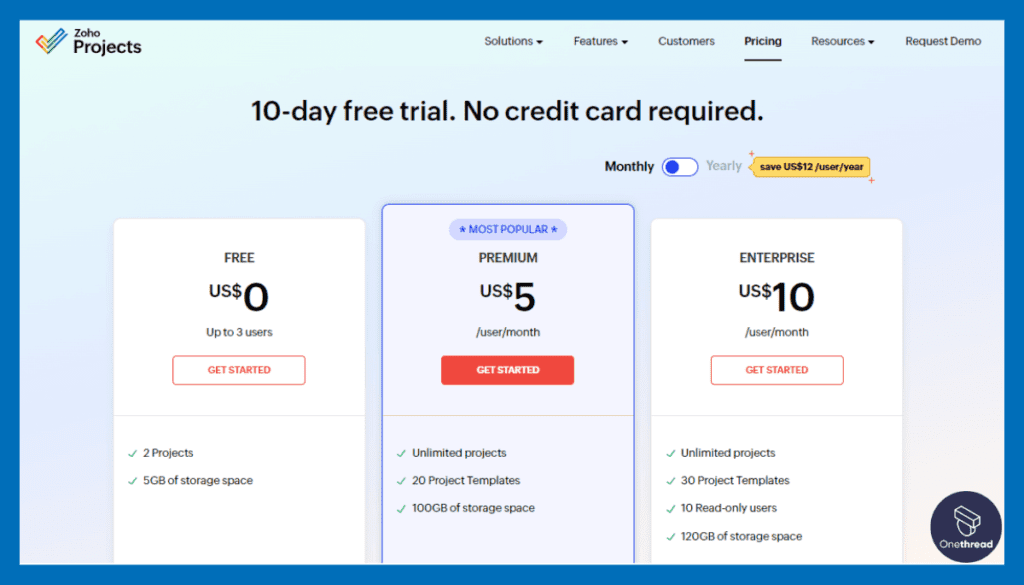
- Free Plan: For small teams with basic functionality.
- Standard Plan: $3 per user/month, added features like task dependencies.
- Express Plan: $4 per user/month, increased storage and customization.
- Premium Plan: $5 per user/month, advanced features like project budgeting.
- Enterprise Plan: $6 per user/month, unlimited users and maximum features.
Is Zoho Projects Better than Hubstaff?
Zoho Projects offers more collaboration features, integrations, and customization options compared to Hubstaff. If a versatile and robust tool that facilitates teamwork and offers diverse views of project progress is essential, Zoho Projects may be the better choice.
Our Review of Zoho Projects
Zoho Projects emerges as a reliable and robust project management solution that caters to varying needs and complexities. Its well-designed interface, extensive feature set, and smooth integration with other tools make it a valuable asset for teams seeking efficiency and alignment.
While it may require some exploration to fully harness its capabilities, the learning curve is mitigated by responsive support and rich resources. Its competitive pricing plans, coupled with adaptability to different industry requirements, solidify its position as a go-to solution for project management.
Basecamp
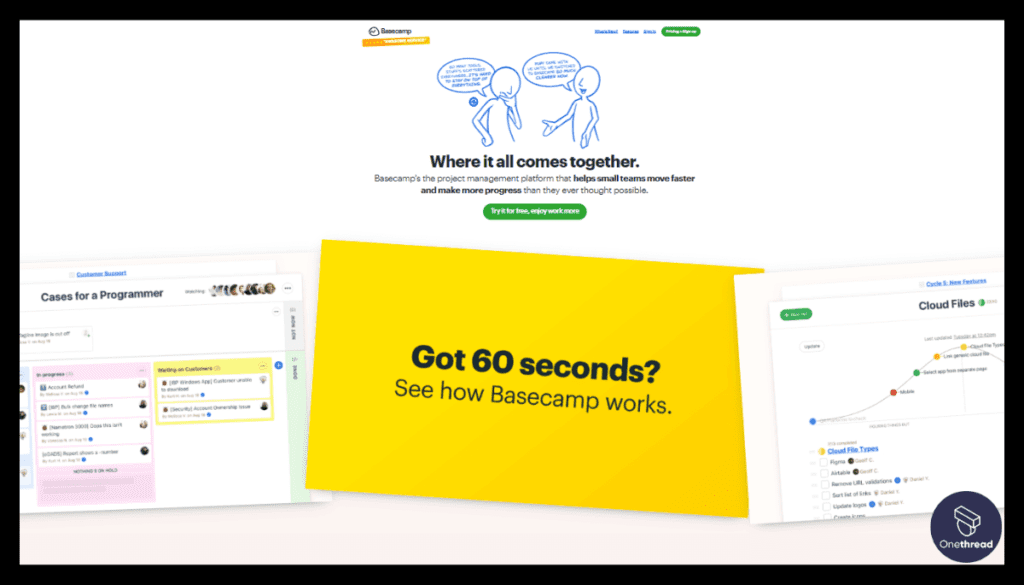
Basecamp, founded in 1999, is a pioneer in online project management and team collaboration. With an emphasis on simplicity and ease of use, Basecamp offers a central space for teams to manage tasks, communicate, and share files.
It enables teams to collaborate and keep track of progress without getting lost in endless email threads. Basecamp’s strength lies in its uncomplicated design, accessibility, and focus on effective communication.
It brings together all aspects of a project into one place, facilitating seamless collaboration.
Features of Basecamp
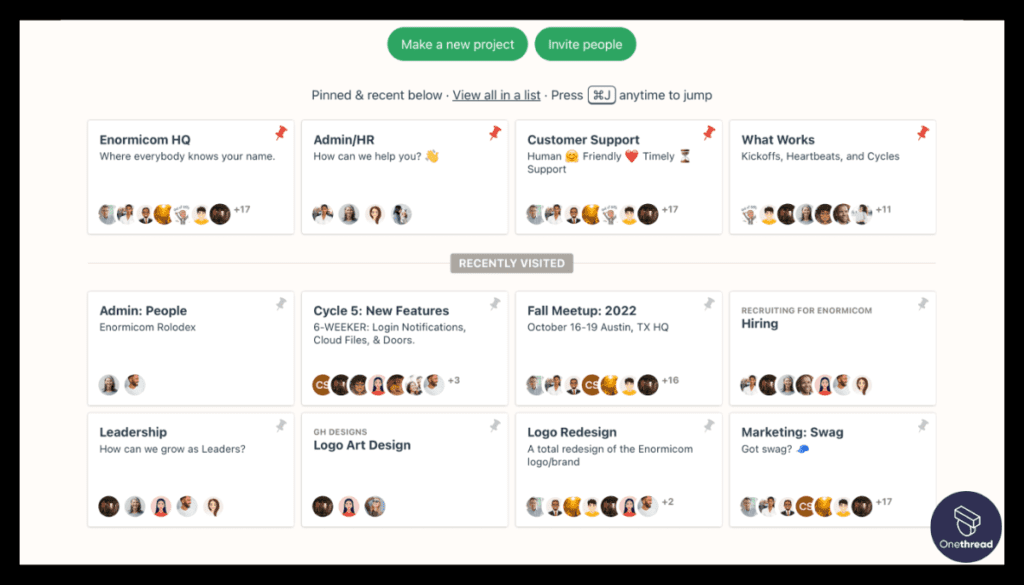
- Holistic Project Management
Basecamp’s project management functionality establishes a virtual workspace where teams can meticulously create, arrange, and oversee projects. It offers a central hub to articulate project objectives, tasks, and pivotal milestones. Each project enjoys an isolated environment, fostering focused collaboration and dedicated tools for efficient teamwork.
- Structured Task Lists
To-do lists within Basecamp furnish an organized approach to task and assignment management. Team members possess the ability to craft tasks, delegate them to specific individuals, set deadlines, and signify their completion. The adaptability of to-do lists accommodates tracking individual responsibilities, collective assignments, and significant project landmarks.
- Interactive Message Boards
Message boards, constituting discussion forums within Basecamp, facilitate team conversations. They facilitate the initiation of dialogues, distribution of updates, and the posting of announcements across distinct threads allocated to diverse topics. This structure ensures orderly discussions, ease of searchability, and unhindered accessibility for team members.
- Real-time Campfire Chat
Campfire, an instantaneous chat function, fosters swift and informal communication. It proves ideal for impromptu discussions, brainstorming endeavors, and the swift sharing of brief updates. Campfire encourages open conversations free from the formality of emails, thus engendering seamless team connectivity and collaboration.
- Secure Document Repository
Basecamp furnishes a secure repository for documents and files. Team members can seamlessly upload various file formats, including images, documents, and presentations. This attribute guarantees that vital materials associated with projects remain effortlessly accessible to the entire team, engendering efficient knowledge sharing.
Pros and Cons
Pros:
- Basecamp’s intuitive interface ensures swift team onboarding
- Basecamp stands as an all-in-one solution
- Basecamp underscores data security by incorporating elements like two-factor authentication and meticulous access controls
Cons:
- It may fall short in accommodating complex workflows due to restricted customization options
Customer Ratings
- G2: 4.1 (5,239+ reviews)
- Capterra: 4.3 (14,244+ reviews)
Pricing
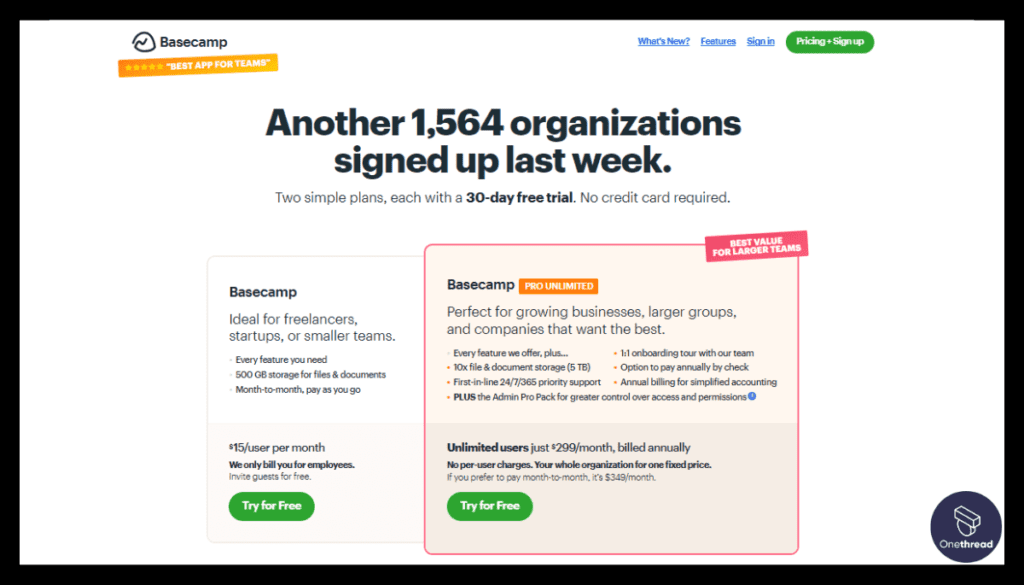
- Personal Plan: Free, suitable for personal projects, freelancers, and families.
- Business Plan: $99 per month, unlimited projects, users, and premium features.
Is Basecamp Better than Hubstaff?
Basecamp’s emphasis on simplicity and communication makes it distinct from Hubstaff. If an intuitive, all-in-one collaboration space without the complexity of traditional project management tools is what you need, Basecamp may be the ideal choice.
Our Review of Basecamp
Basecamp’s longevity in the project management arena speaks volumes about its effectiveness and user satisfaction. Its commitment to providing a clutter-free, unified workspace resonates with teams weary of over-complicated tools.
Its flat-rate pricing also makes it an attractive option for growing teams. If you’re looking for a tool that prioritizes clear communication, easy collaboration, and doesn’t overwhelm with endless features, Basecamp’s tried-and-true approach may be precisely what your team needs.
Its reputation as a steadfast and reliable tool is well-deserved, and it continues to be a favorite among a diverse array of users.
Feature Comparison of Hubstaff Alternatives At a Glance
Tool | Project Management | Customer Support | Collaboration | Workflow Automation |
 | Offers project management tools to plan, organize, and manage projects. | Offers customer support features to assist users. | Provides features for team collaboration and coordination. | Offers limited workflow automation features. |
 | Thread-based project management features to plan, execute, and track projects. | Does not provide specific customer support features. | Provides discussion and comments tools for team communication. | Customizable workflow automation capabilities. |
 | Provides simple drag and drop method of managing projects. | Offers customer support functionalities for users. | Offers collaborative boards for team communication. | Basic Automation with bot |
 | Focuses on time management monitor and manage tasks and projects. | Provides customer support features for user assistance. | Provides collaboration features for team coordination. | Limited workflow automation. |
 | Offers agile-focused project management capabilities for software projects. | Offers customer support functionalities. | Provides collaboration tools for agile project teams. | Provides limited workflow automation for agile processes. |
 | Simple and visual tools for planning, tracking, and managing projects. | Offers customer support features for users. | Provides chat and comments for streamlined teamwork. | Offers workflow automation for process optimization. |
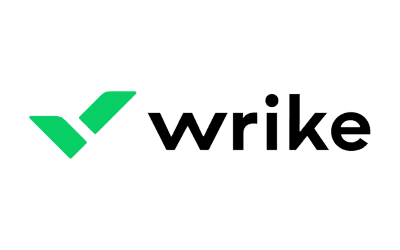 | Offers comprehensive project management features for planning and execution. | Provides customer support for user inquiries. | Provides collaboration tools for team communication. | Limited workflow automation. |
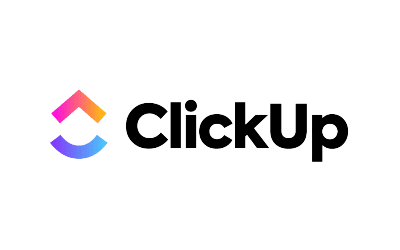 | Vast project management capabilities in one platform | Offers customer support features for user assistance. | Chat, comments and discussion features for communication. | Templates and pre-built automations |
 | Separate toolkits for different aspects of project management | Offers customer support features for user assistance. | Dedicated mail, meetings, and chat functionality. | Distinct app for marketing automation |
 | Task management with multiple visualization options | Does not offer specific customer support functionalities. | 1:1 chats, comments, and sharing capabilities | Scheduling and automatic polling. |
Choosing the Best Hubstaff Alternative
When choosing the best Hubstaff alternative, consider the following:
- Features: If you need robust task management, choose a tool like Onethread.
- Pricing: If you’re on a budget, tools with free plans like Trello might be suitable.
- Accessibility: If cross-platform availability is vital, ClickUp or Zoho Projects might be a fit.
- Ease of Use: If user-friendliness is crucial, Basecamp or Monday.com may be your pick.
Parting Words
Finding the perfect alternative to Hubstaff depends on your team’s unique needs and preferences. With numerous robust options available, there’s an alternative to suit everyone.
By evaluating your priorities and comparing them to our comprehensive guide, you can make an informed decision. Why not start today by trying Onethread? As a versatile and user-centric project management solution, it stands out as a perfect Hubstaff alternative.
Frequently Asked Questions
What are the main features of Hubstaff?
Hubstaff focuses on time tracking, productivity monitoring, and team management, offering detailed reports and integrations.
Is Onethread a free tool?
Onethread may offer different pricing tiers, including a free plan or trial period for users to explore its features.
How does Hubstaff track time?
Hubstaff tracks time through desktop and mobile apps, allowing for accurate monitoring of work hours, breaks, and productivity.
What are the top alternatives to Hubstaff?
Top alternatives include Onethread, Trello, Monday.com, Wrike, Time Doctor, and more, each with distinct features and pricing.
Why choose Onethread over Hubstaff?
Onethread offers powerful task management and collaboration features, coupled with a user-friendly interface, making it an attractive Hubstaff alternative.
